We’ll Never See These Travel Traditions Again – What a Loss!
28 Mar 2025Travel has changed dramatically, becoming simpler and more convenient. But many things from the past added a unique vibe to the journey—even if they were sometimes a little strange. Dress codes on board, fashion shows by flight attendants, free maps at gas stations, and so much more—all of it is gone but remains forever in the memories of those who experienced those times. Who knows what everyday things we take for granted today will disappear in the next 20–30 years? Maybe one day, we’ll look back at airplanes with seats and say, “Remember when you actually had to sit in a cramped space instead of flying lying down in a capsule?”
Cars Were Polished While You Fueled Up
For road travelers, the gas station was often the first stop, and back in the day, it was much more than just a place to fill up the tank.
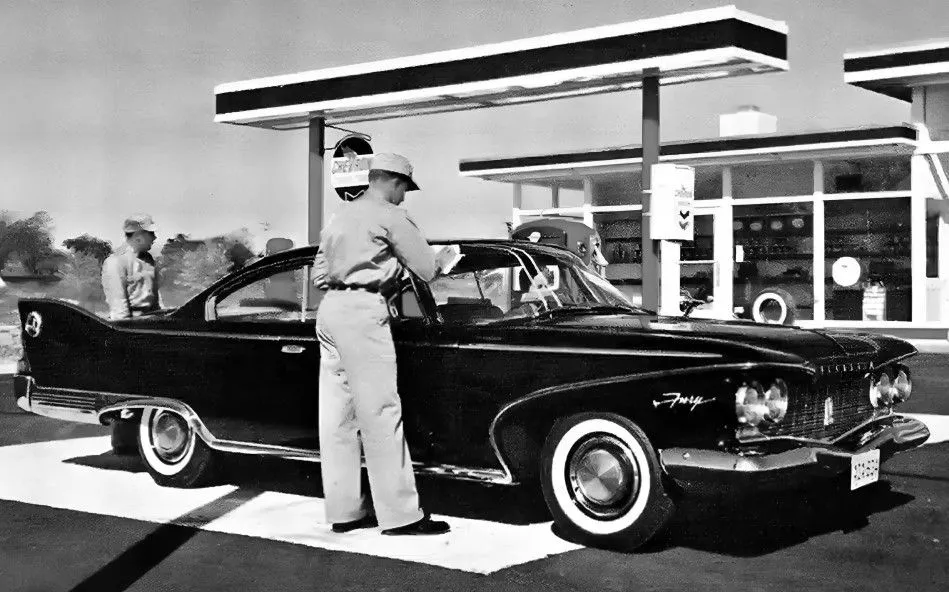 @Gas Station Things We No Longer See!/ Rhetty for History/YouTube.com
@Gas Station Things We No Longer See!/ Rhetty for History/YouTube.com
Gas stations used to offer full service, meaning that while your car was being fueled, attendants would clean your windshield, mirrors, and even polish the body with a special cloth. It was part of a service culture where attendants aimed to ensure that drivers left with both a full tank and a sparkling clean car.
Branded Gas Station Glasses
In the mid-20th century, many gas stations gave away or sold branded drinking glasses with their logos. Shell, Sinclair, and Gulf were among the companies producing collectible glassware that became highly sought-after items.
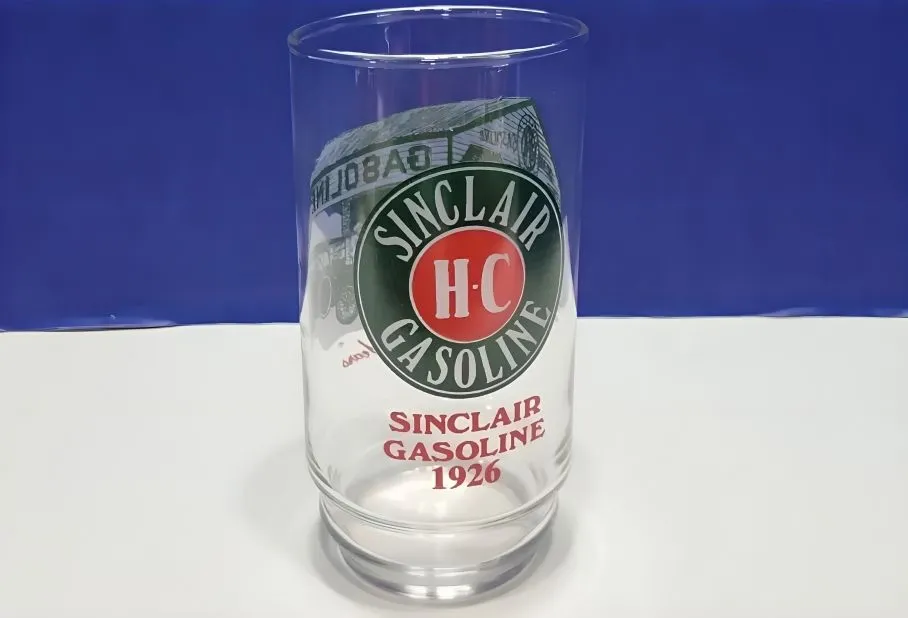 @Gas Station Things We No Longer See!/ Rhetty for History/YouTube.com
@Gas Station Things We No Longer See!/ Rhetty for History/YouTube.com
Some people made it a mission to visit specific stations just to complete their set. While gas stations no longer give out free glassware, collectors still hunt for these vintage pieces at flea markets and auctions.
Tulsa Gift Stamps – A Loyalty Program Before Its Time
Before modern loyalty cards, gas stations encouraged repeat customers with trading stamps. One of the most famous programs was Tulsa Gift Stamps—drivers received stamps when they filled up, which they could paste into a booklet and later exchange for rewards.
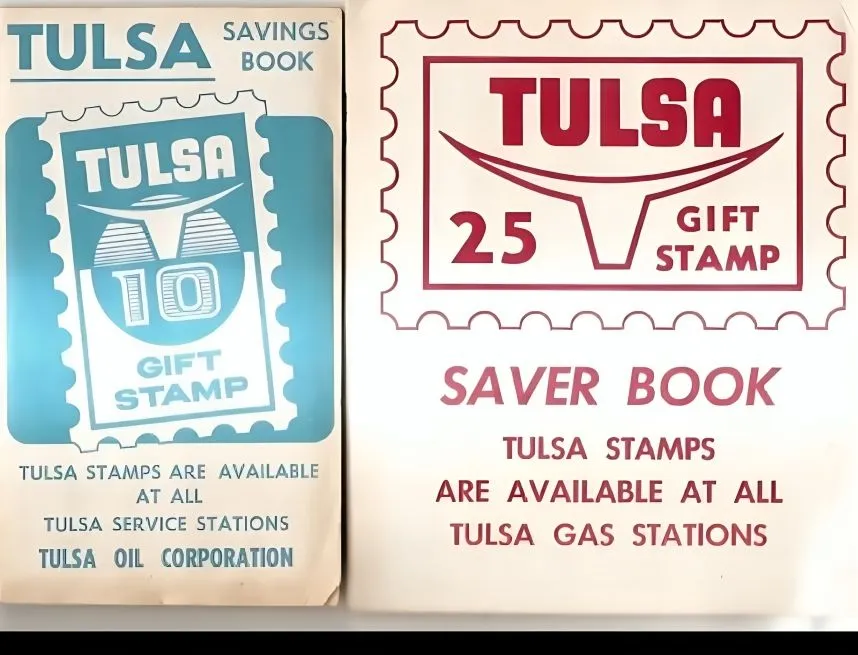 @Gas Station Things We No Longer See!/Rhetty for History/YouTube.com
@Gas Station Things We No Longer See!/Rhetty for History/YouTube.com
These stamps could be redeemed for discounts, free gas, or even household goods. While modern rewards programs have taken their place, the idea of rewarding loyal customers has never gone out of style.
Gas Station Attendant Uniforms Looked Like Police or Military Gear
In the 1950s and '60s, gas station attendants looked extremely professional—their uniforms resembled those of police officers or military personnel. Crisp button-up shirts with epaulets, peaked caps, and even belt buckles gave them an authoritative and polished appearance.
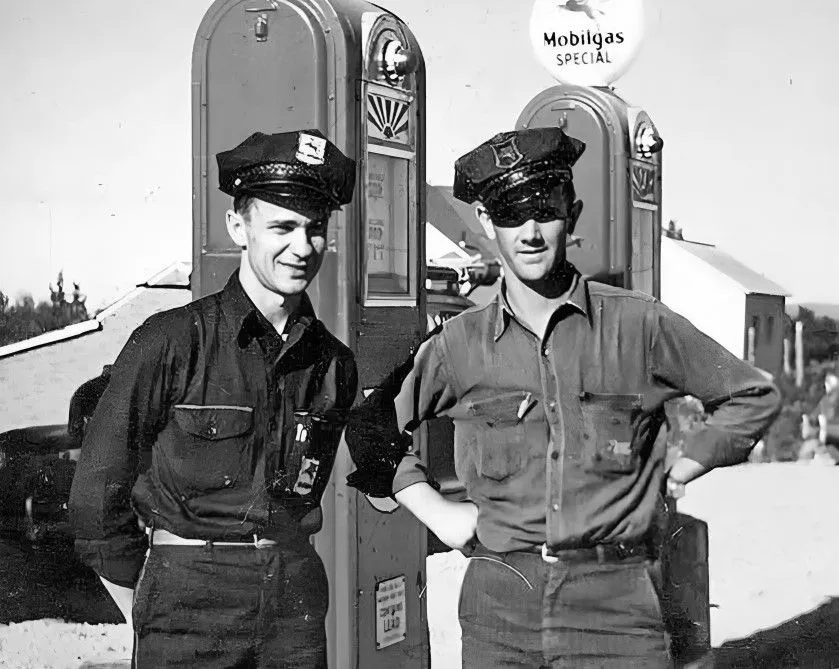 @Gas Station Things We No Longer See!/Rhetty for History/YouTube.com
@Gas Station Things We No Longer See!/Rhetty for History/YouTube.com
This formal style reinforced a sense of discipline and professionalism. Today’s gas station uniforms are much simpler—usually just t-shirts and baseball caps—but the old-school look gave stations a unique charm.
Coca-Cola Vending Machines Were a Gas Station Staple
Nowadays, vending machines are everywhere but there was a time when a gas station without a Coca-Cola machine was unthinkable. Drivers could grab an ice-cold soda and pop the cap right on the machine before getting back on the road.
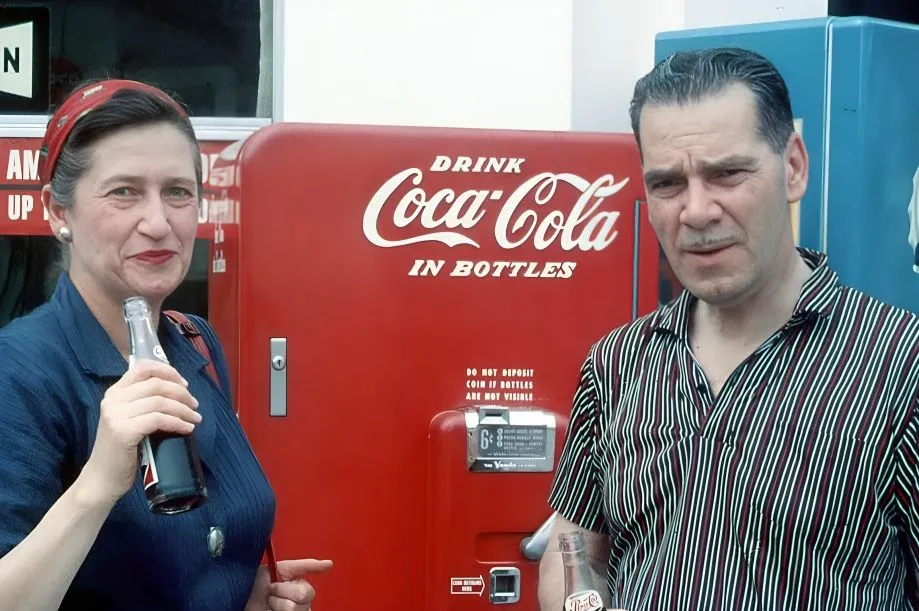 @Gas Station Things We No Longer See!/Rhetty for History/YouTube.com
@Gas Station Things We No Longer See!/Rhetty for History/YouTube.com
These machines often had a retro design with the iconic Coca-Cola logo, and the drinks were always served in glass bottles. While vending machines have evolved, vintage red Coke machines still evoke nostalgia.
Mechanics on Duty for On-the-Spot Repairs
Many gas stations used to have on-site mechanics who could quickly check a car’s condition and fix minor issues. Whether it was a flat tire or an engine problem, these mechanics were there to help.
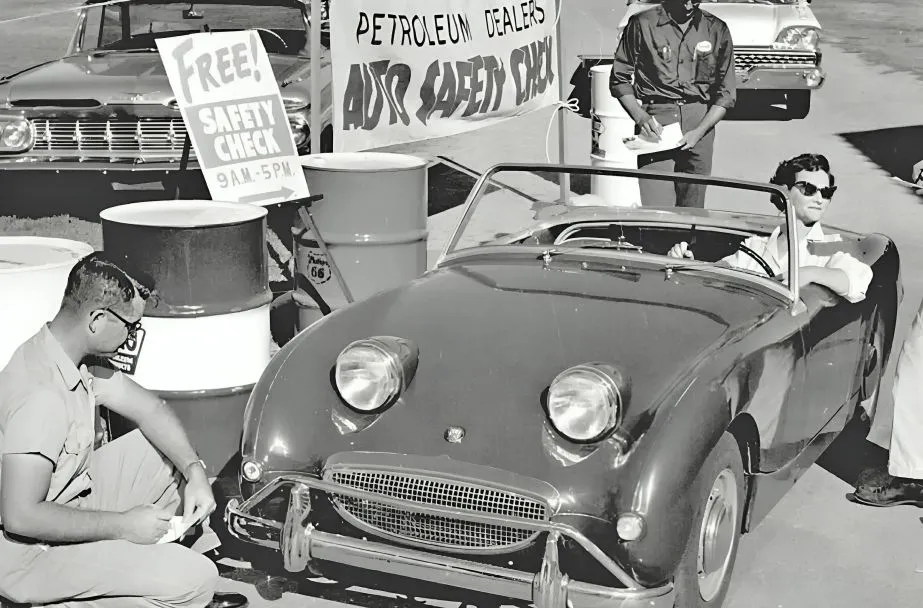 @Gas Station Things We No Longer See!/Rhetty for History/YouTube.com
@Gas Station Things We No Longer See!/Rhetty for History/YouTube.com
This was especially convenient for travelers who ran into trouble on the road. Today, most gas stations have transformed into mini-marts with coffee and snacks, and drivers must visit a repair shop for service.
Free Road Maps for Travelers
Before GPS and smartphones, paper maps were a road trip essential. And the best place to get one? Gas stations! Many stations handed out free road maps featuring routes and service station locations.
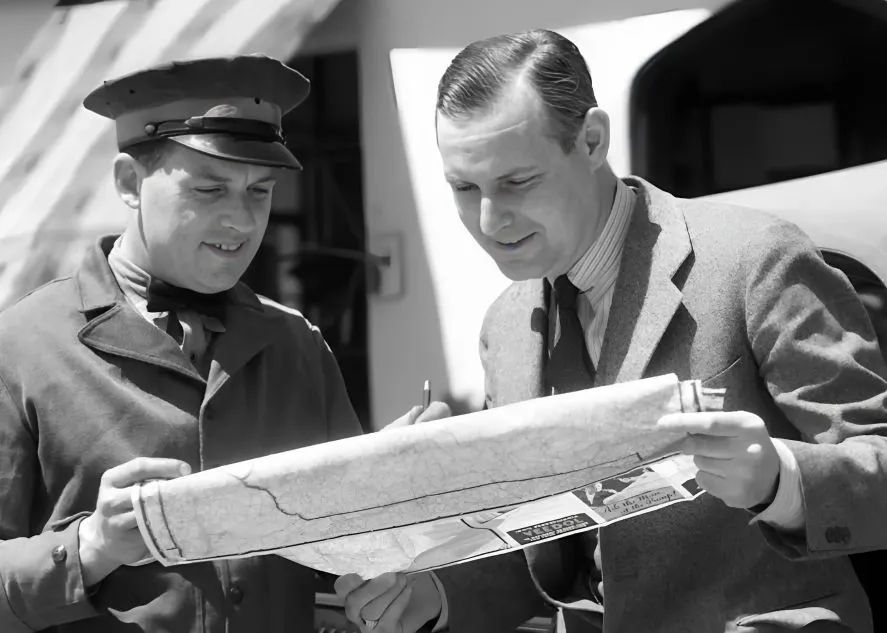 @Gas Station Things We No Longer See!/Rhetty for History/YouTube.com
@Gas Station Things We No Longer See!/Rhetty for History/YouTube.com
It was an excellent marketing strategy—drivers got a useful tool while also being subtly reminded where to refuel. Some maps were beautifully designed with illustrations, driving tips, and scenic route suggestions. Pretty cool, right?
Car Manufacturer-Branded Gas Stations
Today, gas stations are owned by major oil companies but in the past, some were branded by car manufacturers. For example, Ford and Chevrolet once had their own gas station networks, offering fuel “recommended for their vehicles.”
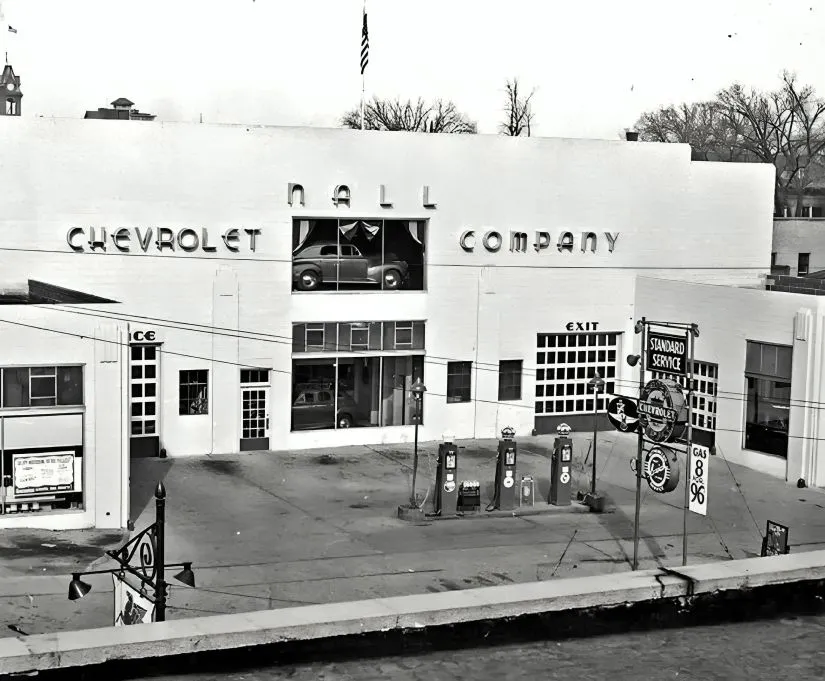 @Gas Station Things We No Longer See!/Rhetty for History/YouTube.com
@Gas Station Things We No Longer See!/Rhetty for History/YouTube.com
This built customer trust—where better to refuel your Ford than at a Ford station? Some of these stations even had cars for sale right on site, allowing drivers to check out a new model while filling up!
The Era of Leaded Gasoline
One of the biggest differences between past and present gas stations is the disappearance of leaded gasoline. For much of the 20th century, leaded fuel was used to reduce engine knocking.
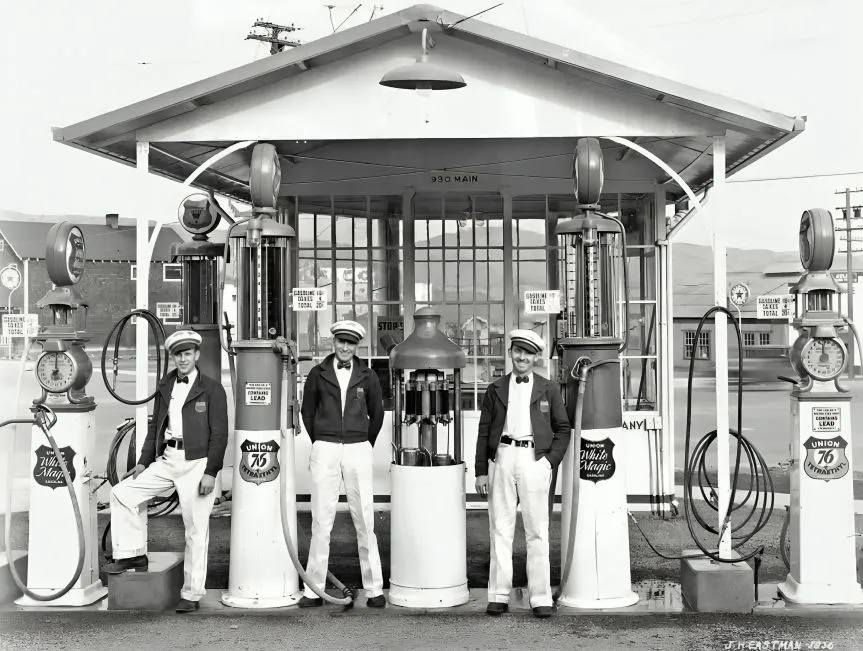 @Gas Station Things We No Longer See!/Rhetty for History/YouTube.com
@Gas Station Things We No Longer See!/Rhetty for History/YouTube.com
However, it was later discovered that lead was harmful to both people and the environment, leading to its phase-out by the late 1990s. Back in the day, gas stations had separate pumps for “Leaded” and “Unleaded” fuel, and drivers had to know which type their car required. Today, that choice no longer exists—leaded gasoline is banned in most countries.
Hot Stewardess Uniforms
If the journey was long and flying was the only option, it was at least incredibly comfortable! Today, flight attendant uniforms are elegant and strict but in the ’60s and ’70s, airlines focused on seductiveness. Mini-skirts, high boots, tight dresses—stewardesses looked like supermodels. For example, in the 1970s, Southwest Airlines had uniforms featuring short shorts and knee-high socks, while Braniff International dressed their flight attendants in bright, form-fitting suits and even plastic space-age helmets.
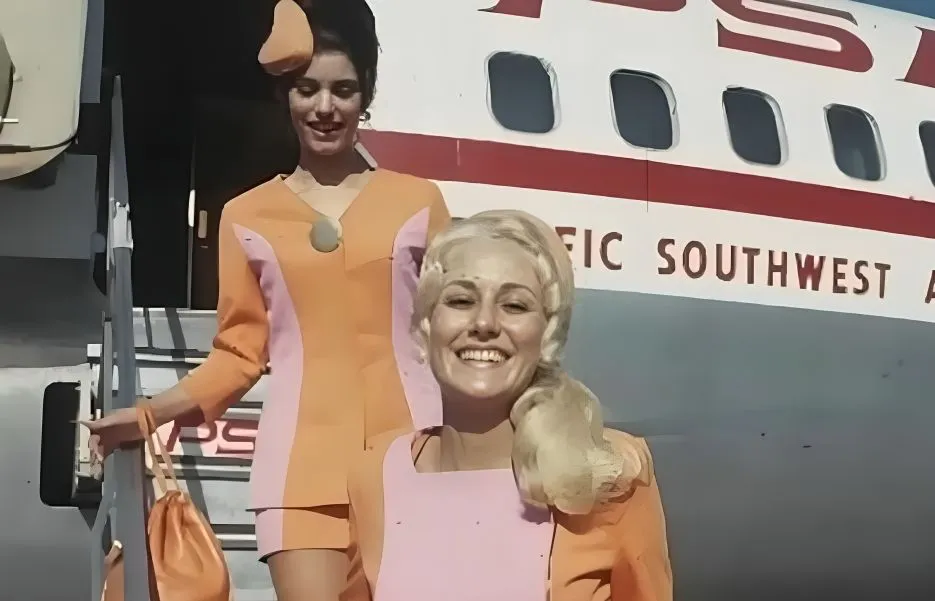 @Lost Features of Air Travel During the Golden Age of Flying/Recollection Road/YouTube.com
@Lost Features of Air Travel During the Golden Age of Flying/Recollection Road/YouTube.com
Airlines actively promoted the idea of "hot stewardesses" because commercial aviation was still a novelty, and any way to attract passengers was fair game. Ads from that era even stated outright: "Our stewardesses are part of your in-flight pleasure!"
The Chef Onboard
In the 1950s–70s, airlines offered full-fledged restaurant service—you could feel like you were dining in a Michelin-starred restaurant mid-air. It wasn’t just a tray with reheated pasta; passengers could actually see a chef stepping into the cabin and personally serving their meals. The menu featured steak, lobster, caviar, and gourmet desserts, all served on fine china with silverware and proper wine glasses. For example, Pan Am flights to Europe offered dishes inspired by Michelin-starred French restaurants. Nowadays, you won’t even find such luxury in business class.
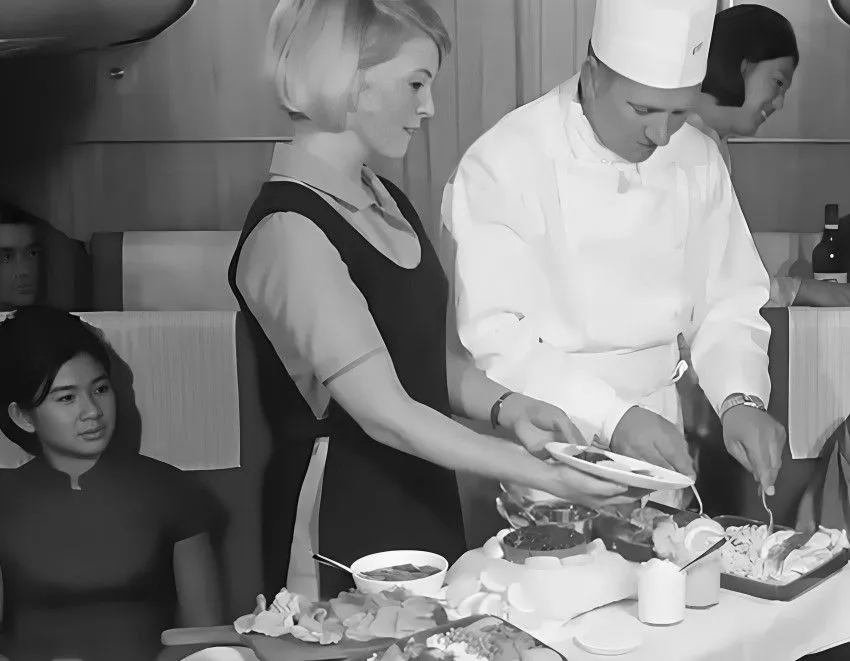 @Lost Features of Air Travel During the Golden Age of Flying/Recollection Road/YouTube.com
@Lost Features of Air Travel During the Golden Age of Flying/Recollection Road/YouTube.com
Why did it disappear? First, air travel became more accessible, and serving every passenger lobster became too costly. Second, airlines started cutting costs on everything, including meals.
Smoking Onboard – Why Not?
Today, the thought of lighting up a cigarette on a plane seems absurd but back then, it was completely normal. There were even designated smoking rows on planes—as if the smoke wouldn't spread throughout the cabin anyway. Moreover, many airlines gave out free cigarettes to passengers! In the 1970s, Pan Am and United Airlines even handed out complimentary mini packs of cigarettes as a "thank you" for flying.
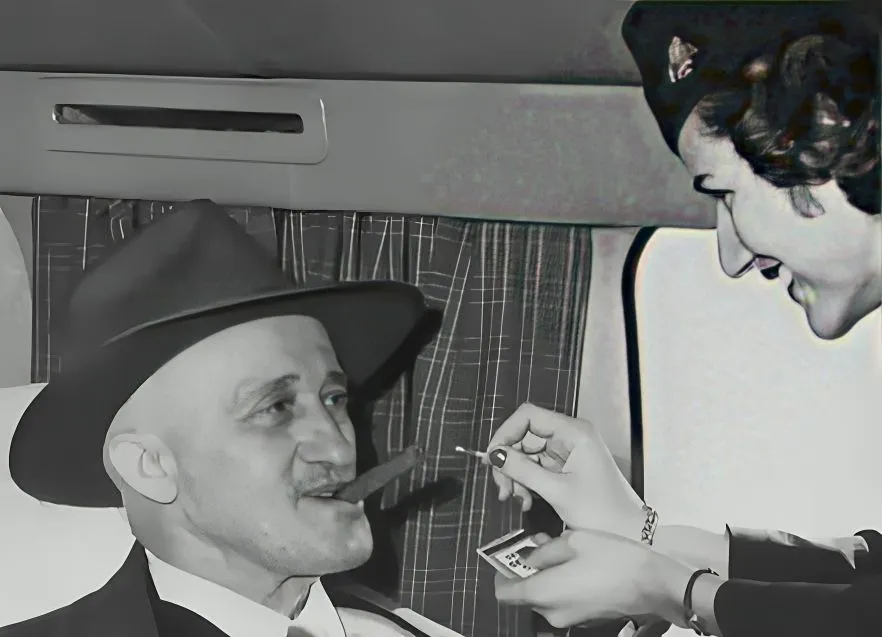 @Lost Features of Air Travel During the Golden Age of Flying/Recollection Road/YouTube.com
@Lost Features of Air Travel During the Golden Age of Flying/Recollection Road/YouTube.com
Of course, this created an awful atmosphere for non-smokers. Imagine sitting through a 10-hour flight while someone next to you chain-smokes… No wonder it was eventually banned. Plus, let’s be honest, it wasn’t exactly the safest idea.
Airport Phone Booths
Nowadays, before takeoff, we just text our friends and family: "Already at the airport, taking off soon!" or "Boarded, talk later!" But back then, it was a completely different story.
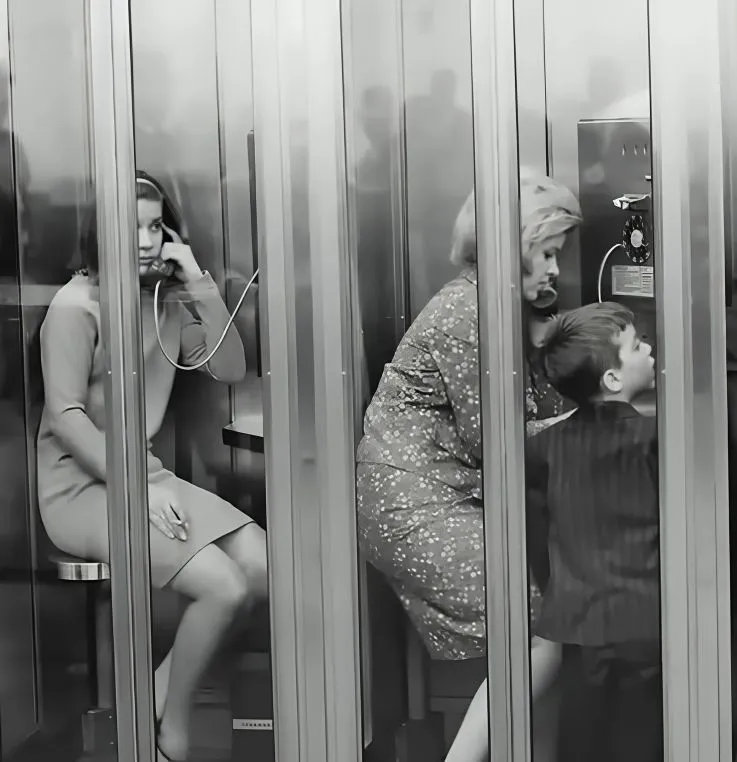 @Lost Features of Air Travel During the Golden Age of Flying/Recollection Road/YouTube.com
@Lost Features of Air Travel During the Golden Age of Flying/Recollection Road/YouTube.com
Airports were lined with phone booths where passengers would make a final call to their loved ones or colleagues before departure. It was practically a ritual—step into the booth, drop a coin, and quickly say, "I'm at the airport, about to take off!" because every second on the line cost money.
Airport Insurance Stands
Nowadays, we buy travel insurance online but back then, airports had dedicated vending machines and counters selling “airline trip insurance.” Passengers could purchase coverage in just a few minutes by filling in a relative’s name as the beneficiary in case of a crash. It was a bit unsettling—a stark reminder that planes could go down.
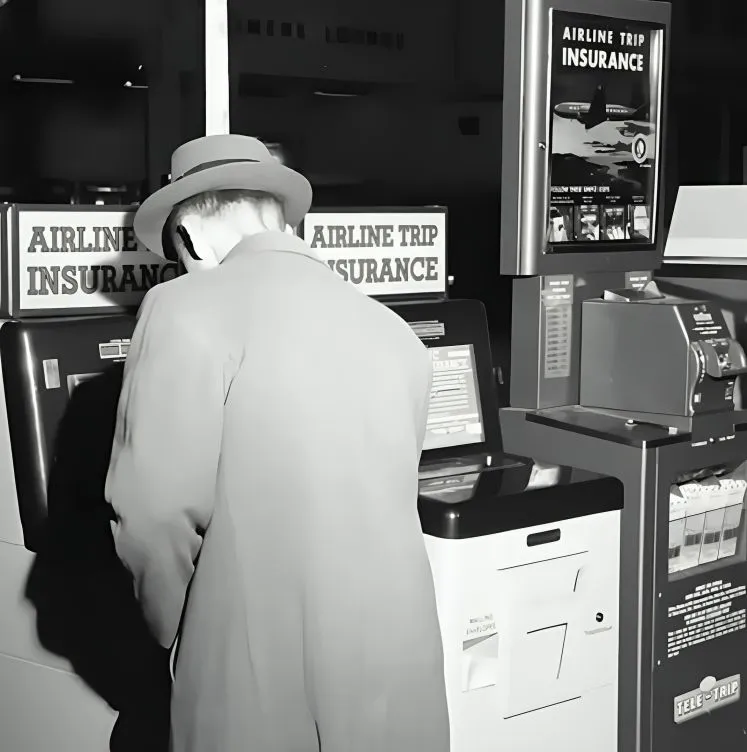 @Lost Features of Air Travel During the Golden Age of Flying/Recollection Road/YouTube.com
@Lost Features of Air Travel During the Golden Age of Flying/Recollection Road/YouTube.com
Yet, insurance companies made millions from it, as fear of flying was (and still is) very real. Many passengers, overwhelmed by last-minute nerves, would rush to buy a policy even if they hadn’t planned to.
Mini-TVs in Airport Lounges
Modern airport waiting areas are filled with massive screens showing news or sports—or passengers just scroll on their phones. But back in the day, airport lounges had small personal televisions—and, surprise, they worked on coins!
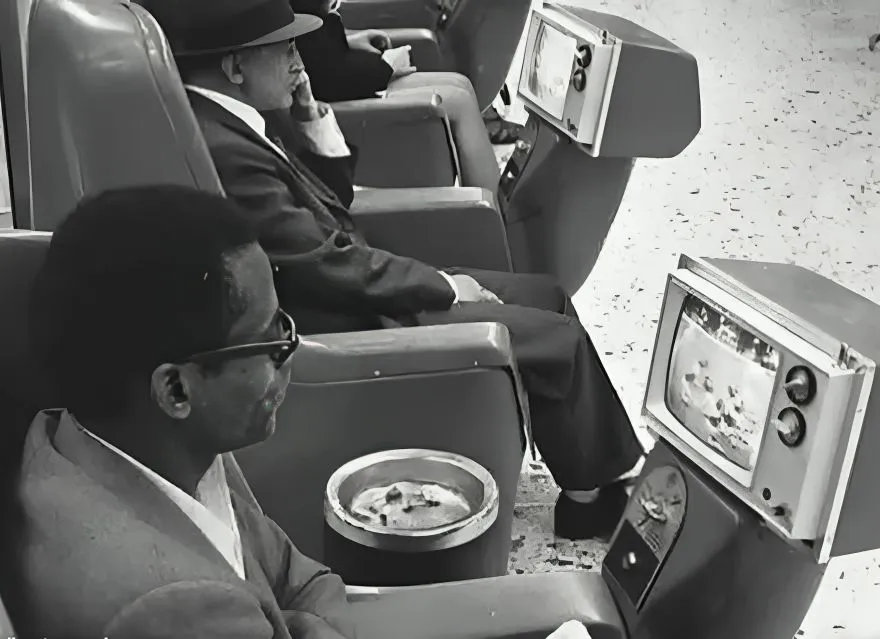 @Lost Features of Air Travel During the Golden Age of Flying/Recollection Road/YouTube.com
@Lost Features of Air Travel During the Golden Age of Flying/Recollection Road/YouTube.com
Yes, to pass the time before a flight, you’d drop a coin into the slot, and the TV would play for 10–15 minutes. There was something oddly amusing about it—people would pop in a coin, settle into their chairs, and then, when the screen abruptly turned off, realize they had to pay again.
Flying Meant Dressing Up!
Today, airport fashion consists of hoodies, sweatpants, and even pajamas. But in the 1950s and ’60s, flying was a grand event, not just a way to get from point A to point B. Men wore elegant suits, polished leather shoes, and stylish hats. Women arrived in planes wearing exquisite dresses, perfectly styled hair, and gloves.
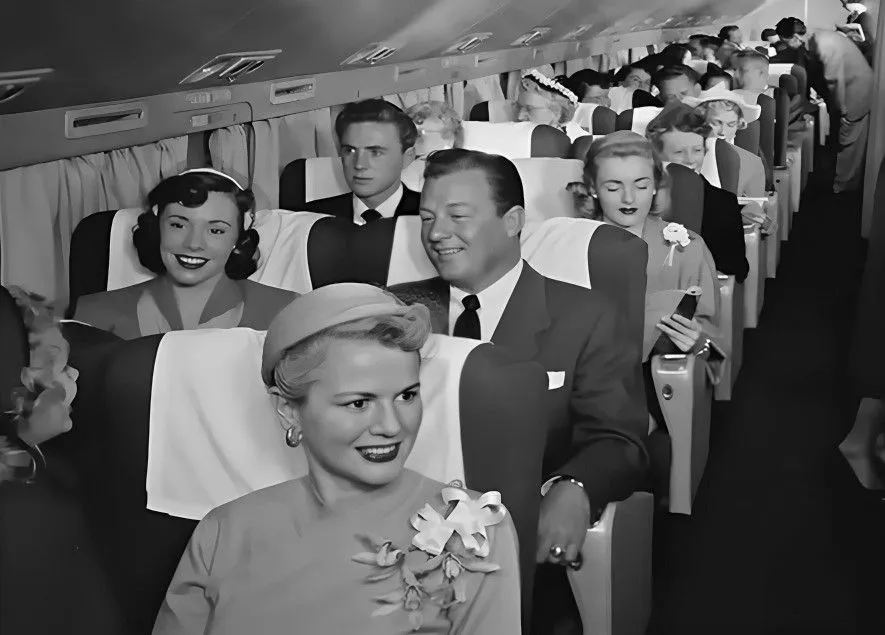 @Lost Features of Air Travel During the Golden Age of Flying/Recollection Road/YouTube.com
@Lost Features of Air Travel During the Golden Age of Flying/Recollection Road/YouTube.com
Not everyone could afford to fly, so if you were boarding a plane, you had to look the part. Some airlines even enforced a dress code—if a passenger wasn’t dressed formally enough, they might not be allowed to board!
Open Cockpits
Today, cockpit doors resemble bank vaults but back in the day… they might not have even existed! Passengers could freely peek inside, watch the pilots in action, and sometimes even chat with them.
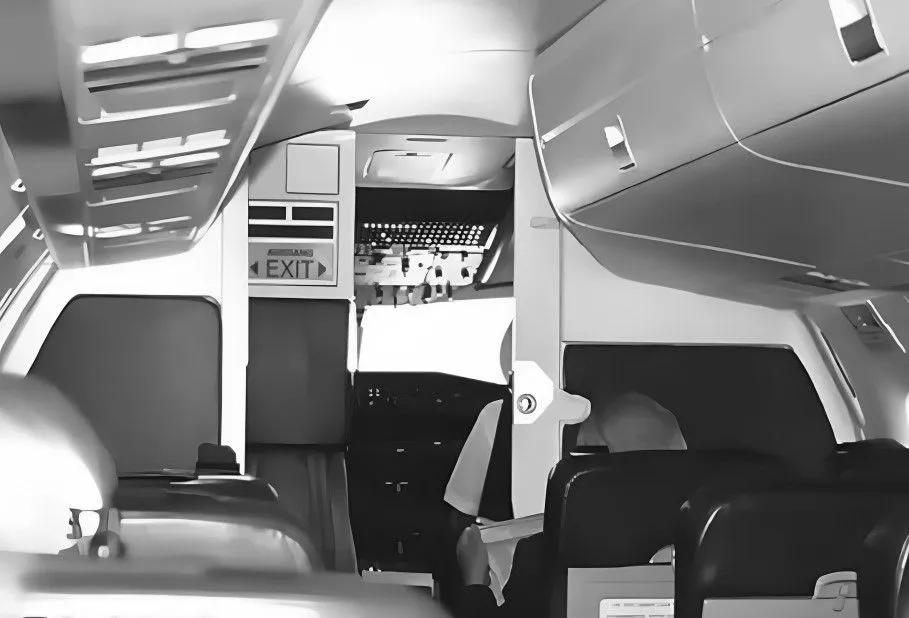 @Lost Features of Air Travel During the Golden Age of Flying/Recollection Road/YouTube.com
@Lost Features of Air Travel During the Golden Age of Flying/Recollection Road/YouTube.com
Kids were often invited in to take pictures at the controls, and no one thought twice about it. After a series of hijacking incidents, security became much stricter, and now the cockpit is an impenetrable fortress.
Overhead Sleeping Berths – Almost Like a Train!
Today, the idea of getting proper sleep on a plane (unless you're in business class) sounds like a fantasy. But in the 1950s–60s, some long-haul planes actually had overhead sleeping berths! These were real beds positioned above the regular seats, allowing passengers to climb up and stretch out instead of contorting themselves into an uncomfortable sitting position.
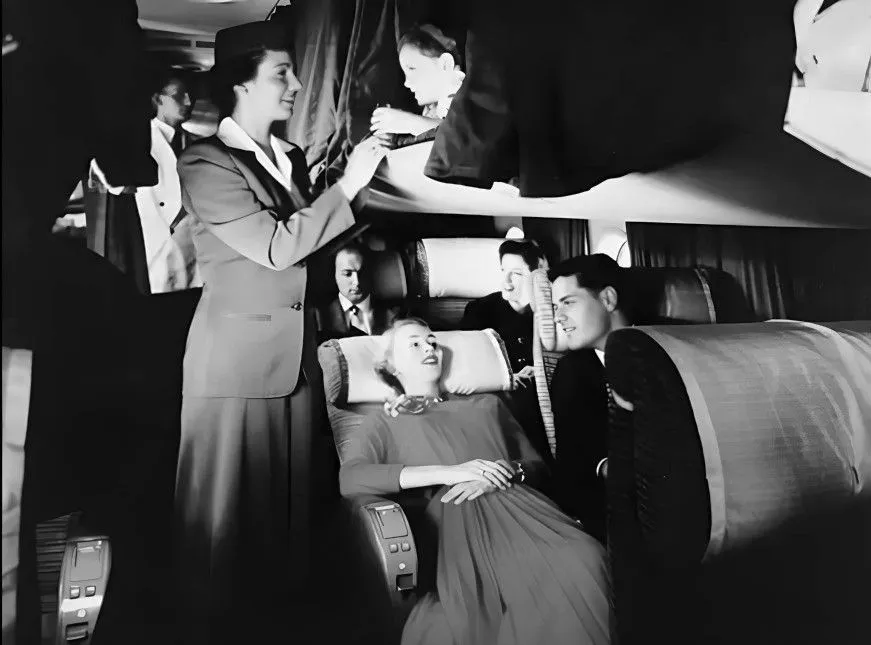 @The Golden Age of Flying: a fascinating look at the 1950s and '60s!/ Ritzy Travel Guide/YouTube.com
@The Golden Age of Flying: a fascinating look at the 1950s and '60s!/ Ritzy Travel Guide/YouTube.com
One of the most comfortable flying experiences was on the Boeing 377 Stratocruiser, where the upper berths resembled cozy train compartments, giving passengers a proper place to sleep. Nowadays, such luxury is reserved for airlines like Emirates but at one time, even economy-class travelers could enjoy it.
Lounge Areas Onboard
Old-school airplanes had real lounges where passengers could do much more than just sit in their seats. They could stroll around, socialize with fellow travelers, play chess, or even light up a cigar.
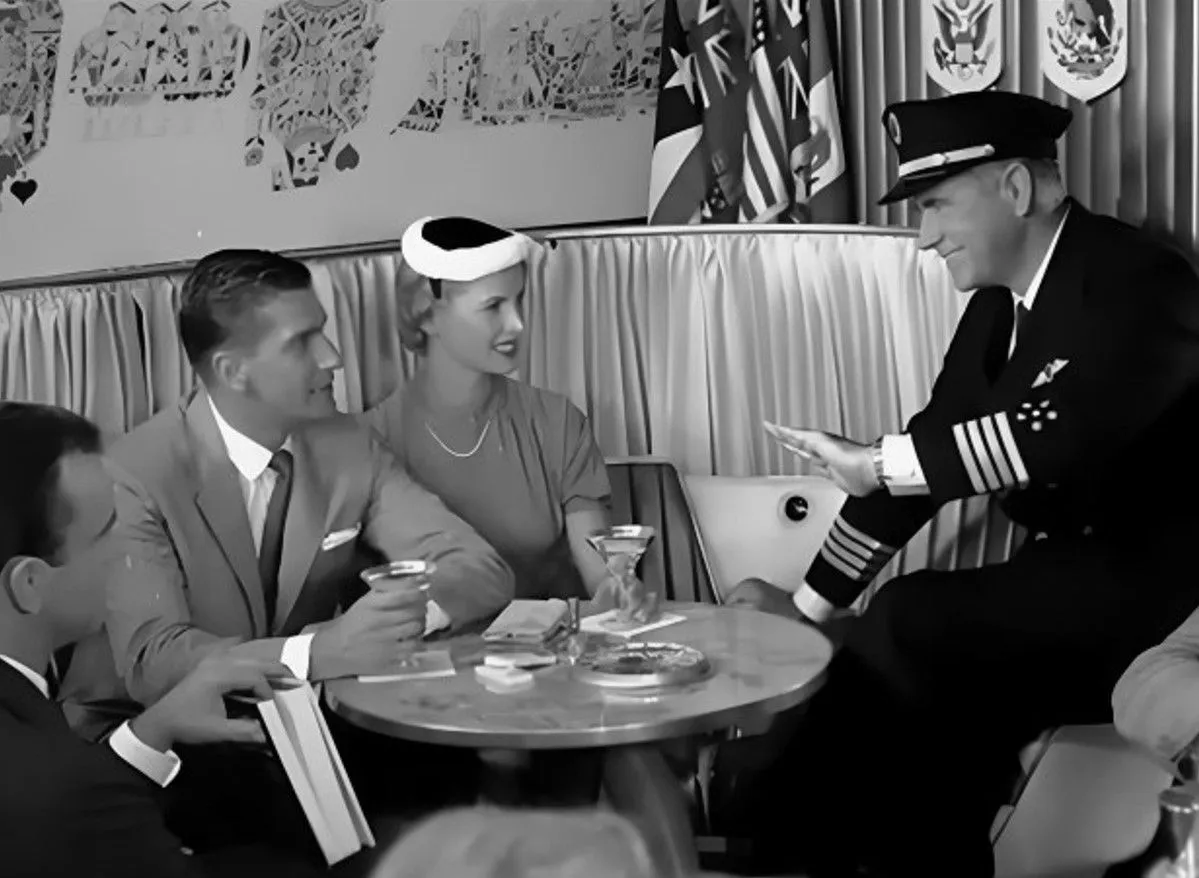 @The Golden Age of Flying: a fascinating look at the 1950s and '60s!/Ritzy Travel Guide/YouTube.com
@The Golden Age of Flying: a fascinating look at the 1950s and '60s!/Ritzy Travel Guide/YouTube.com
For instance, the Lockheed Constellation featured a dedicated lounge bar where passengers could relax at comfortable tables, sip cocktails, and engage in sophisticated conversations. Some aircraft even had separate smoking areas—not just a few designated rows at the back but full-fledged smoking lounges.
No Time for Boredom – Pianists and Live Shows!
Today, the most entertainment you get on a flight is a seatback screen with movies and music. But in the past, airlines brought live performances right to the skies! Between the 1950s and 1970s, some airlines hosted full-on concerts in the air. Pianists played jazz, singers performed hit songs, and sometimes, fashion shows even took place mid-flight.
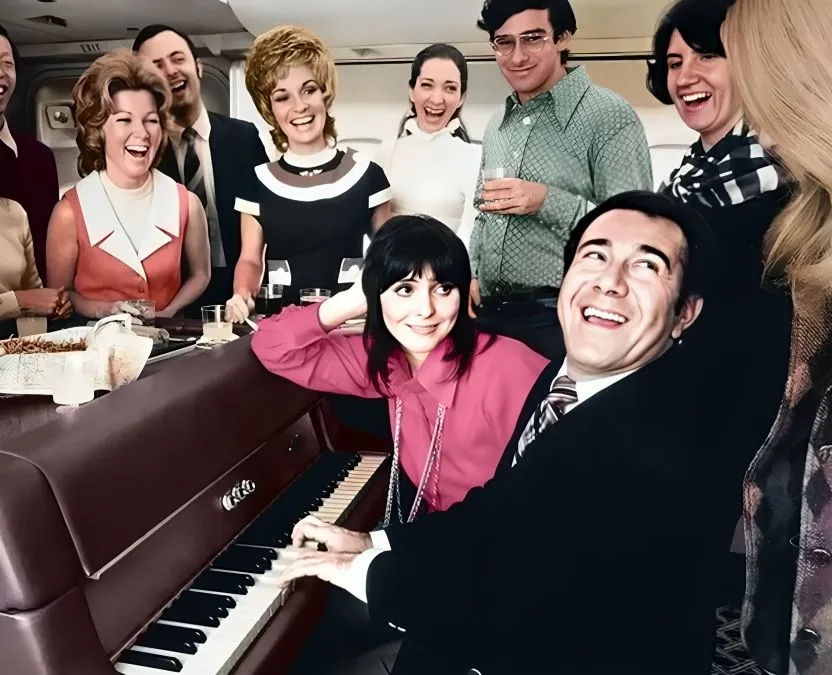 @10 Air Travel Features From The Golden Age Of Flying/American Rewind/YouTube.com
@10 Air Travel Features From The Golden Age Of Flying/American Rewind/YouTube.com
American Airlines' Boeing 747 had an onboard mini-restaurant with a piano bar, where passengers could sip cocktails while enjoying live music. Imagine flying across the Atlantic, surrounded by the smooth sounds of a jazz band—like being in an exclusive club at 30,000 feet.
Seats That Turned Into Full Beds
Modern economy class often feels like a cramped tin can, with passengers forced to sit with their knees pressed against the seat in front. But in the 1950s–70s, even economy class offered an incredible level of comfort.
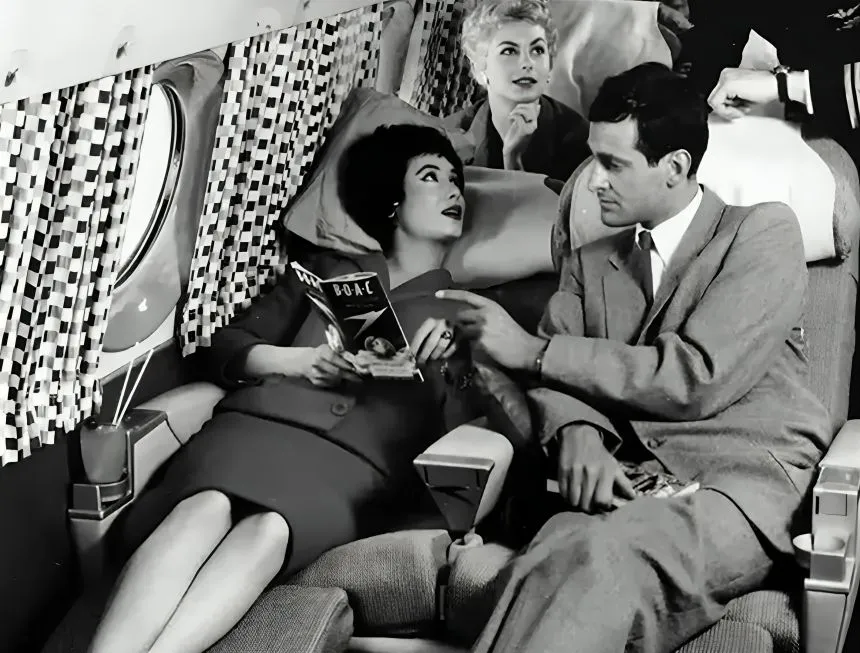 @10 Air Travel Features From The Golden Age Of Flying/American Rewind/YouTube.com
@10 Air Travel Features From The Golden Age Of Flying/American Rewind/YouTube.com
Seats were wide, with tall backrests and plenty of legroom. Some even reclined almost flat, allowing passengers to stretch out like in a proper bed. The reason? Airlines didn’t pack flights as tightly as they do now. With fewer passengers, there was simply more space—and much more comfort.
Flight Attendant Fashion Shows Were a Big Deal
Flight attendant uniforms weren’t just about branding; they were a statement of style. Airlines like Braniff International went so far as to host full runway shows, unveiling their latest flight attendant looks.
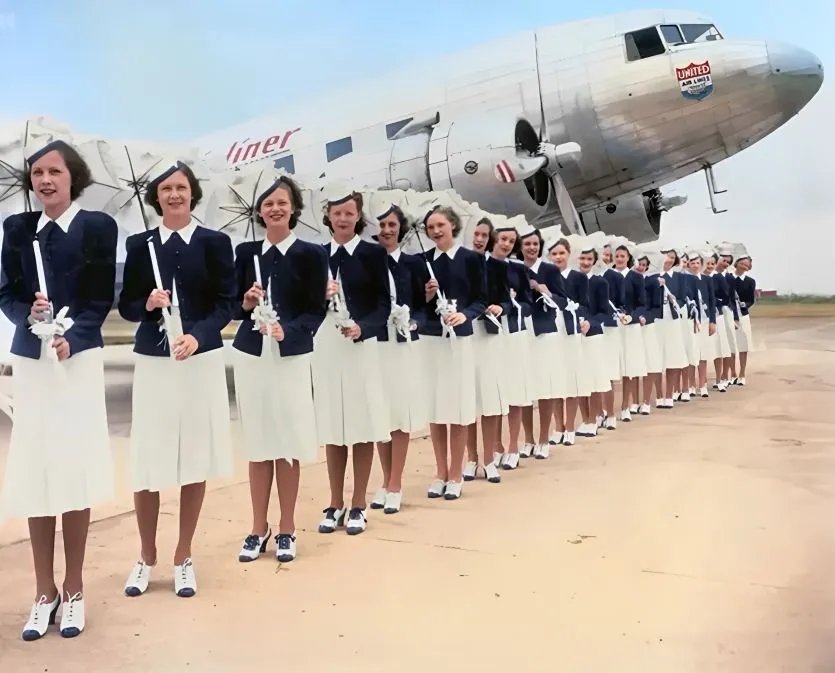 @10 Air Travel Features From The Golden Age Of Flying/American Rewind/YouTube.com
@10 Air Travel Features From The Golden Age Of Flying/American Rewind/YouTube.com
These uniforms featured mini-skirts, knee-high boots, bold colors, and even space-age helmets that looked like something out of a sci-fi movie. Airlines competed to have the most fashionable crew, and flight attendants weren’t just staff—they were style icons.
Airplanes Looked Like Luxury Hotels
Step onto a plane today, and you’re greeted with gray plastic panels, narrow seats, and a design focused purely on functionality. But in the 1960s, airplanes looked more like the lobby of an upscale hotel.
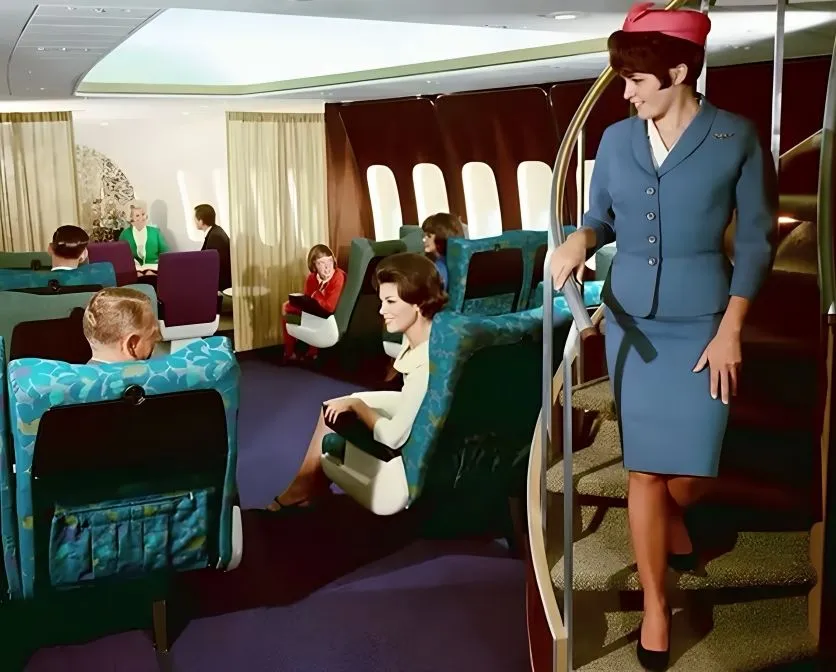 @10 Air Travel Features From The Golden Age Of Flying/American Rewind/YouTube.com
@10 Air Travel Features From The Golden Age Of Flying/American Rewind/YouTube.com
Think polished wooden panels, plush carpeting, and velvet or leather-upholstered seats—zero plastic, zero generic design. Some planes even had spiral staircases leading to lounge areas on an upper deck, where passengers could sip champagne in comfort.
No Strict Security Measures
Nowadays, getting on a plane feels like an obstacle course—shoes off, laptops out, liquids in tiny bottles, multiple scans. But in the 1950s, airport security was almost nonexistent. Passengers' bags were often not even checked. If you looked respectable, you were simply waved onto the plane.
 @10 Air Travel Features From The Golden Age Of Flying/American Rewind/YouTube.com
@10 Air Travel Features From The Golden Age Of Flying/American Rewind/YouTube.com
In some airports, people could walk directly onto the tarmac to say goodbye to loved ones right by the aircraft steps. Of course, times have changed, and these relaxed policies are long gone but it’s wild to imagine such a carefree travel experience today.
Glamorous Post-Flight Photoshoots
Today, most passengers step off a plane looking exhausted, in wrinkled t-shirts with messy hair. But in the 1950s, disembarking from a flight was like walking a red carpet.
 @10 Air Travel Features From The Golden Age Of Flying/American Rewind/YouTube.com
@10 Air Travel Features From The Golden Age Of Flying/American Rewind/YouTube.com
Women adjusted their hats and gloves, men strode confidently in perfectly tailored suits, and photographers in airports captured their stylish arrivals. Airports even had professional photographers dedicated to snapping photos of passengers as they stepped off the plane—talk about a glamorous way to travel!
Googie Architecture
When we think of old motels and hotels, we often imagine quirky buildings with bright, strange facades. This is Googie architecture — a style that was popular in the mid-20th century, especially in the United States. Bold colors, unusual shapes, signs, and more…
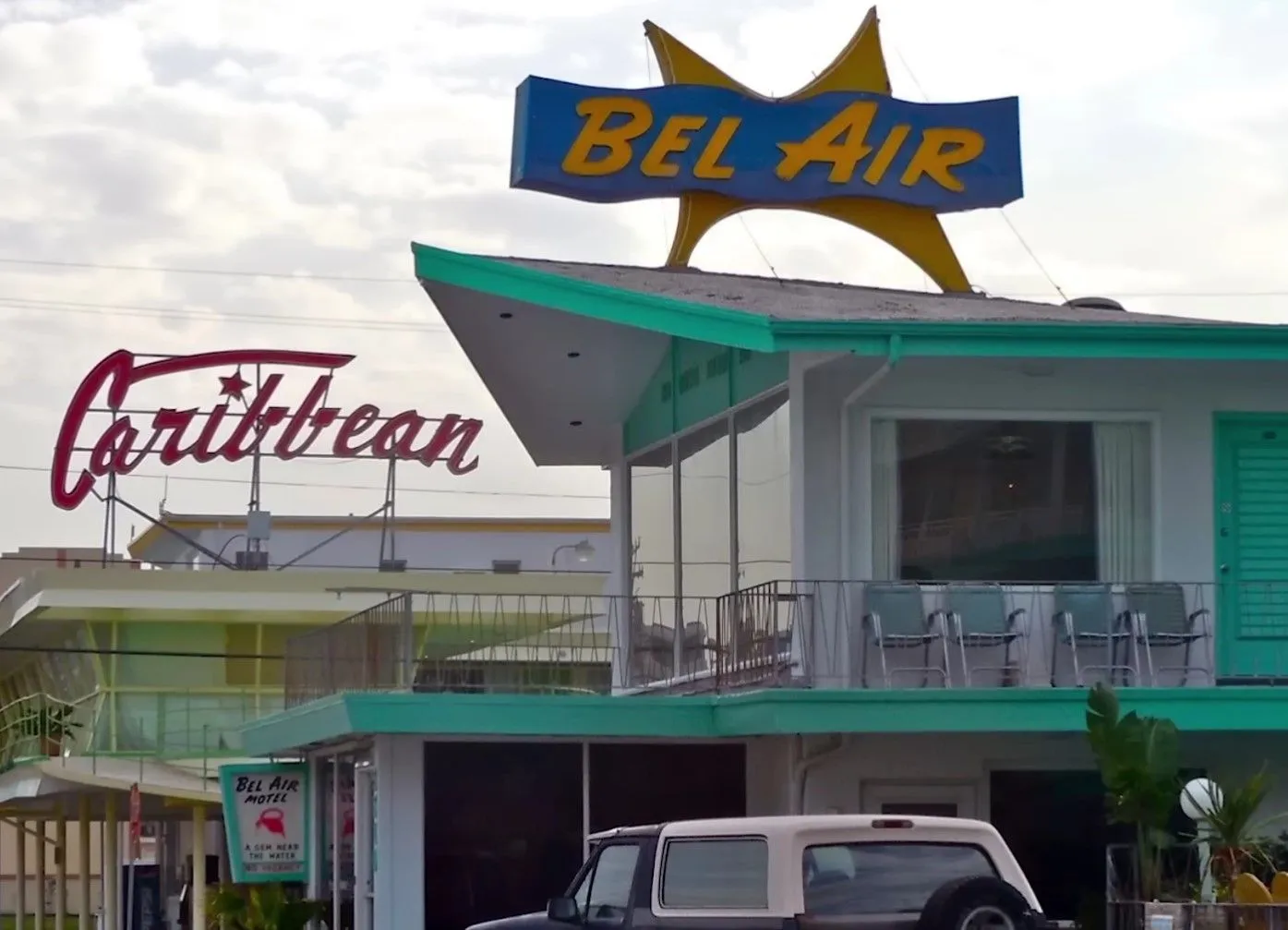 @11 Hotel Features You Won’t Find Anymore/American Rewind/YouTube.com
@11 Hotel Features You Won’t Find Anymore/American Rewind/YouTube.com
This style was especially characteristic of roadside motels, small cafes, and other establishments catering to travelers. These buildings looked as if they were from the future: sharp-pointed roofs, bright neon signs, even plastic elements! Today, of course, this style has disappeared but sometimes, as you walk past old motels, you can still find these reminders of the past… nostalgia!
Massage Beds – Sounds Tempting!
In past decades, some hotels had real massage beds — something truly incredible for its time. They looked like ordinary beds but with a secret — a built-in mechanism that provided a massage at the touch of a button. These beds were equipped with vibrating mattresses or rollers inside that helped relieve tension after a long day of traveling.
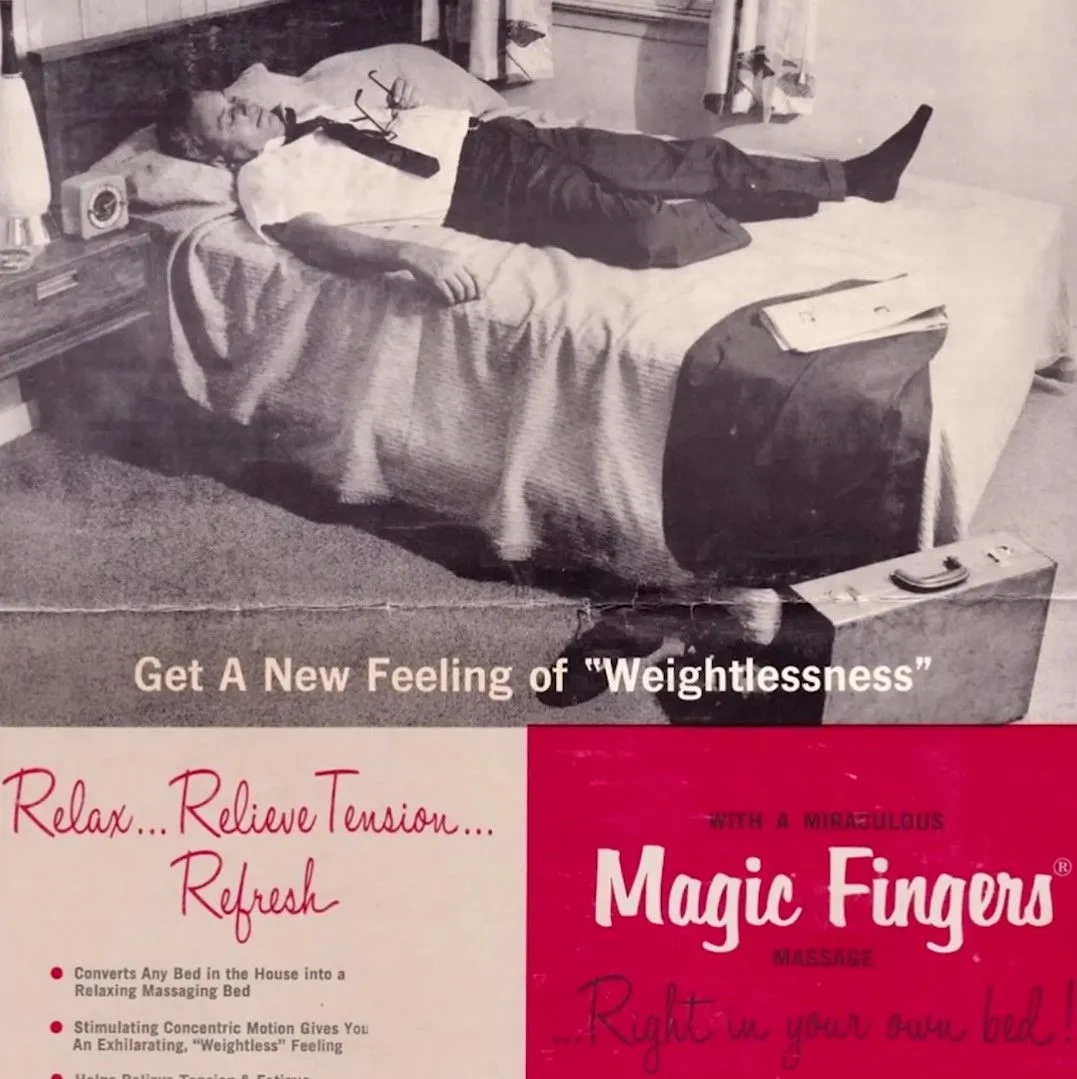 @11 Hotel Features You Won’t Find Anymore/American Rewind/YouTube.com
@11 Hotel Features You Won’t Find Anymore/American Rewind/YouTube.com
Interestingly, this innovation, often considered the "future of hotel service," may today become part of modern spa programs that hotels use to attract clients looking to rest and recover. So if you're a hotel owner, it might be worth considering!
Hotel Postcards
A bit of nostalgia — many people remember those wonderful hotel postcards you could find in hotel lobbies. The perfect souvenir from your trip! These postcards usually depicted the hotel itself, its main halls, and often had blank spaces on the back for writing messages.
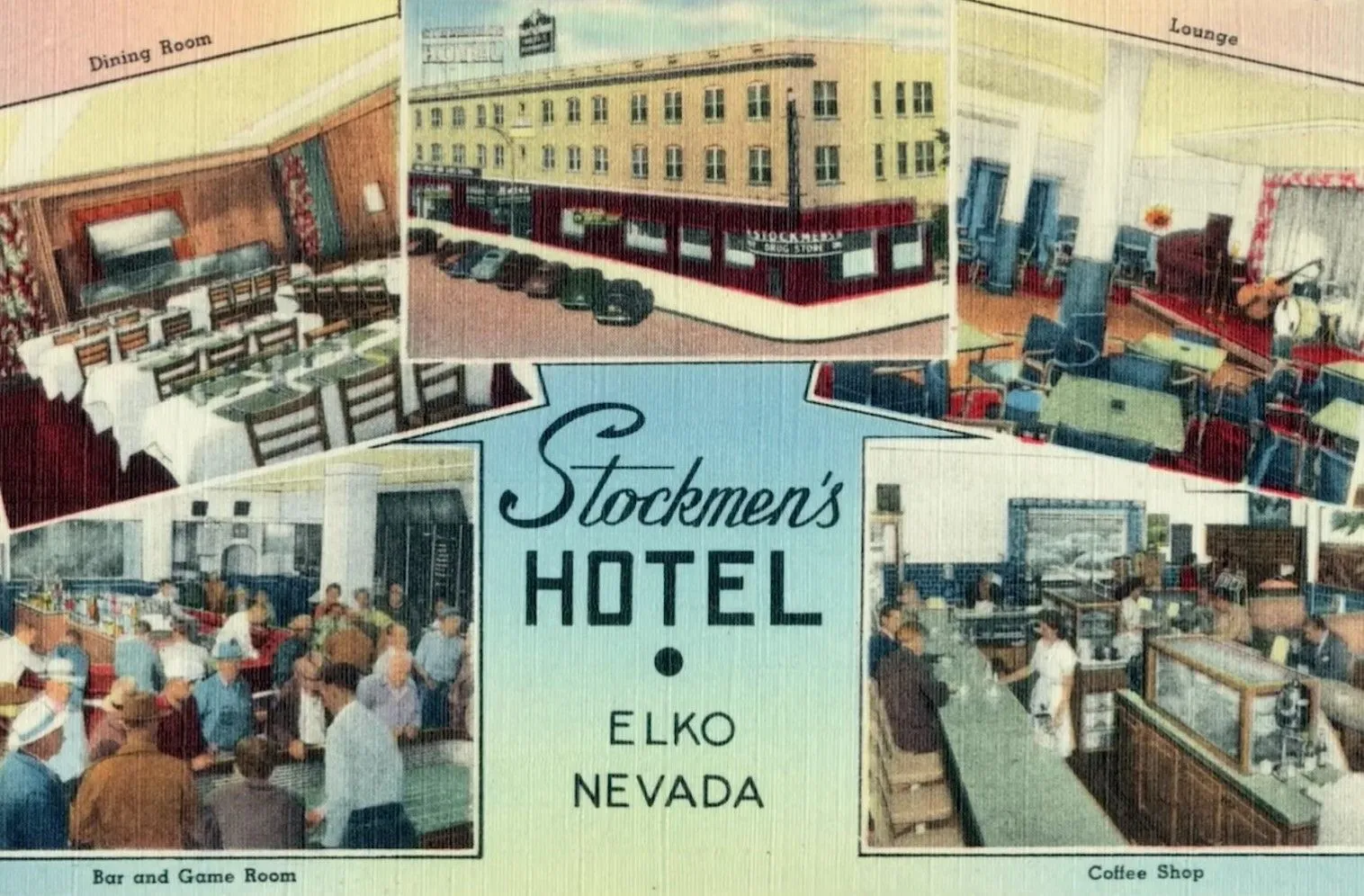 @11 Hotel Features You Won’t Find Anymore/American Rewind/YouTube.com
@11 Hotel Features You Won’t Find Anymore/American Rewind/YouTube.com
What’s particularly interesting is that in past years, these postcards were mass-produced in hotels. You didn’t have to pay extra for them — they were often included in the cost of the room, making them even more popular among tourists. Who doesn’t love free souvenirs?
Metal Room Keys
Yes, once upon a time, every hotel gave you a metal key with a bright number on it. These keys were often heavy, with large keychains that you could carry as a reminder of your visit. Today, room keys in most hotels are replaced by plastic cards, which are easily lost but metal keys had their own charm.
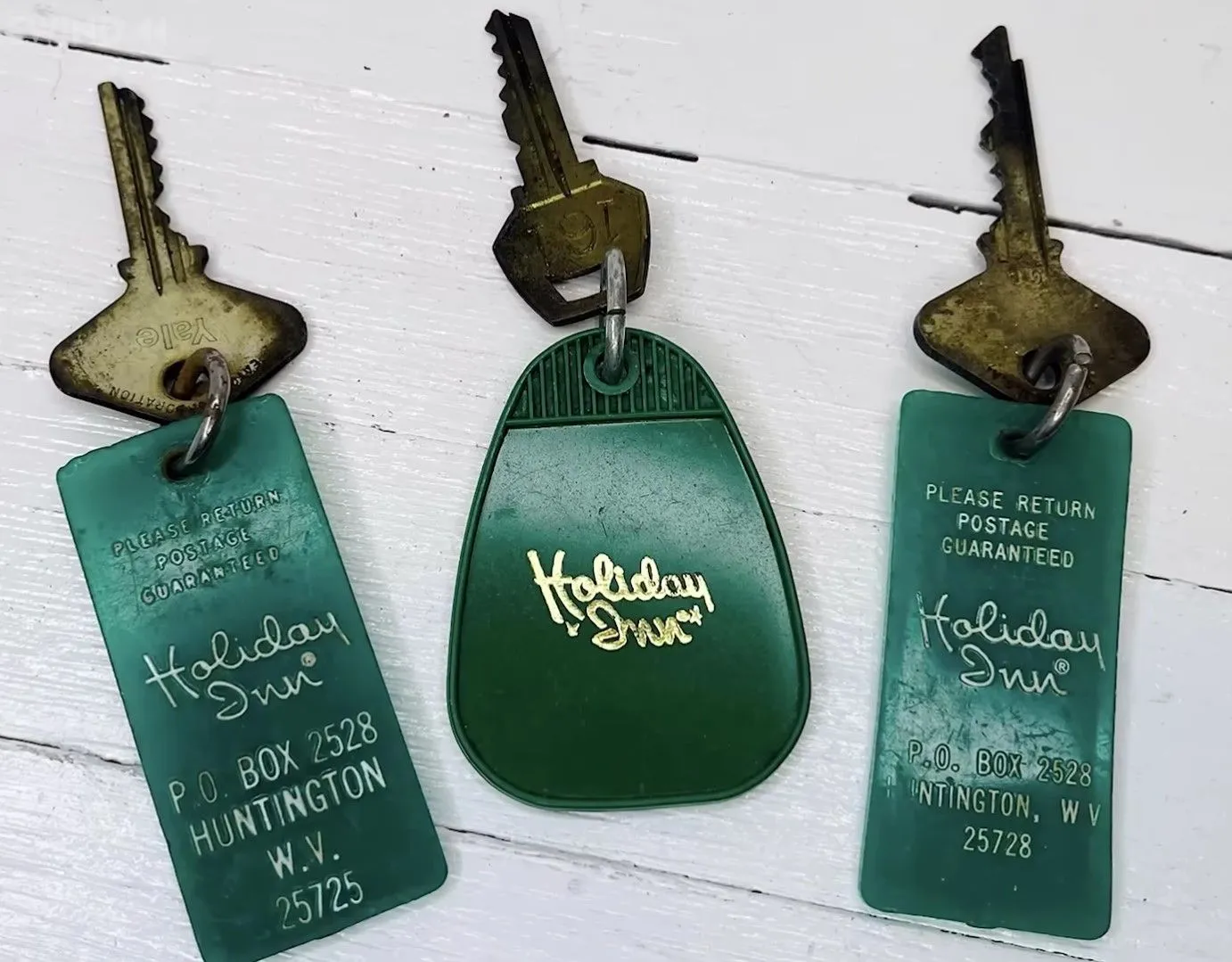 @11 Hotel Features You Won’t Find Anymore/American Rewind/YouTube.com
@11 Hotel Features You Won’t Find Anymore/American Rewind/YouTube.com
And often, metal keys were decorated with the hotel or city’s emblem, making them look beautiful as well.
Letters from Guests and Ads
Another significant element of old hotels was the guest book. It was like an archive of travelers: on one page, guests wrote their names and reviews by hand, and on the next, there were all sorts of advertisements and offers.
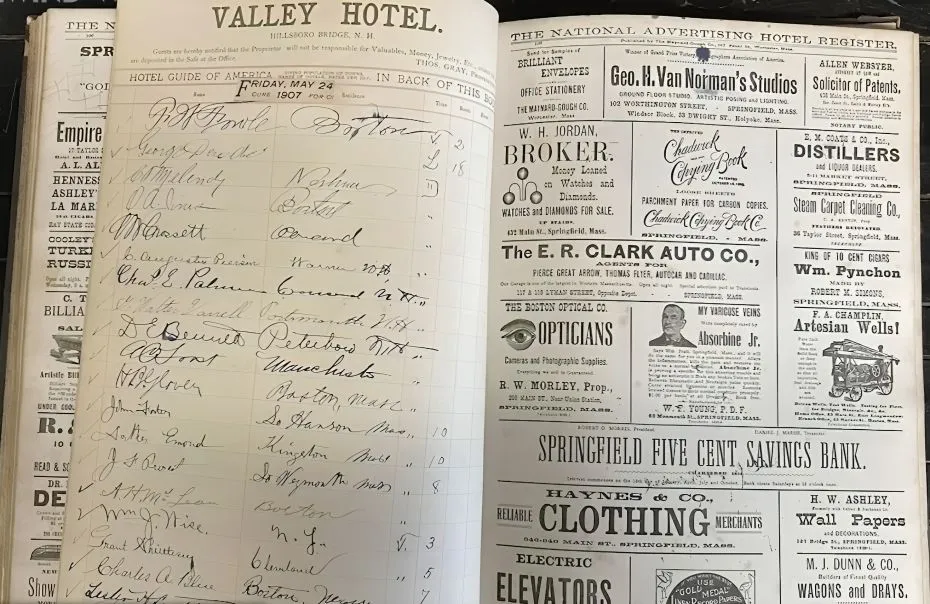 @11 Hotel Features You Won’t Find Anymore/American Rewind/YouTube.com
@11 Hotel Features You Won’t Find Anymore/American Rewind/YouTube.com
Hotel guests would share their impressions, experiences, and sometimes even leave small notes or jokes, which later became part of the hotel's history. Today, guest books are mostly kept as decor in boutique hotels. Unfortunately, not many people write in them anymore… This tradition has remained in the past, and that’s a shame!
Bibles in Hotel Rooms
In the past, it was almost always possible to find a Bible in every room of old hotels. These Bibles were often placed in nightstands or on tables in the rooms.
 @11 Hotel Features You Won’t Find Anymore/American Rewind/YouTube.com
@11 Hotel Features You Won’t Find Anymore/American Rewind/YouTube.com
Sometimes, these books were adorned with beautiful leather covers and golden letters, making them not just a sacred text but also a part of the interior design. Today, books in hotel rooms have become a rarity (especially Bibles).
No Way Without Bright, Colorful Beds!
One of the most distinctive elements of old hotel rooms was, of course, the beds. Back in the day, many hotels, in an attempt to create a bright interior, often chose vibrant, colorful colors for their bedding. Imagine: beds with red, green, purple, or orange covers, pillows with geometric patterns. The brighter, the better!
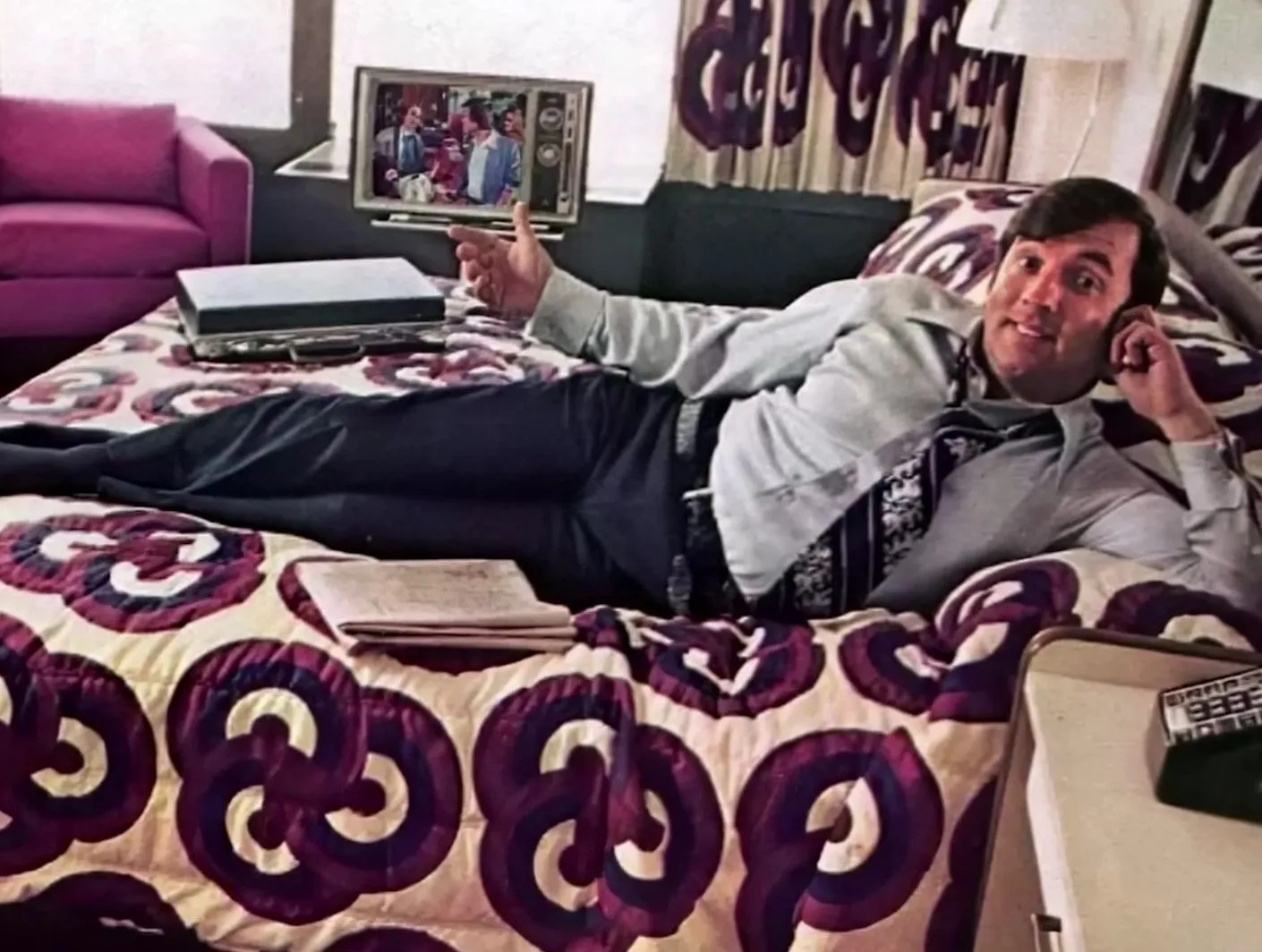 @11 Hotel Features You Won’t Find Anymore/American Rewind/YouTube.com
@11 Hotel Features You Won’t Find Anymore/American Rewind/YouTube.com
These beds were often surrounded by a strange combination of old wallpaper and chairs that didn’t match each other at all. Today, of course, we prefer more restrained, calm colors but looking at retro photos of hotels, you realize that there was also a charm in all that brightness.
Men’s Corner in the Heart of the Hotel
In the past, many hotels, especially large and expensive ones, had barber shops right in the lobby or on the second floor. For many men, it was a convenient way to freshen up their hairstyle or shave while traveling.
 @11 Hotel Features You Won’t Find Anymore/American Rewind/YouTube.com
@11 Hotel Features You Won’t Find Anymore/American Rewind/YouTube.com
Moreover, they didn’t just offer traditional haircuts but also massage or shaving services. Today, these barber shops have almost disappeared but some modern premium hotels are bringing back this tradition!
Smoking Rooms with a Hostess
There was a time when smoking was allowed just about everywhere, and hotels didn’t just tolerate it—they embraced it. Some even had dedicated smoking lounges. But the real highlight wasn’t the rooms themselves but how they looked. Picture this: plush armchairs, tables with ashtrays, and a hostess who would bring guests cigarettes, drinks, and even light their cigars for them.
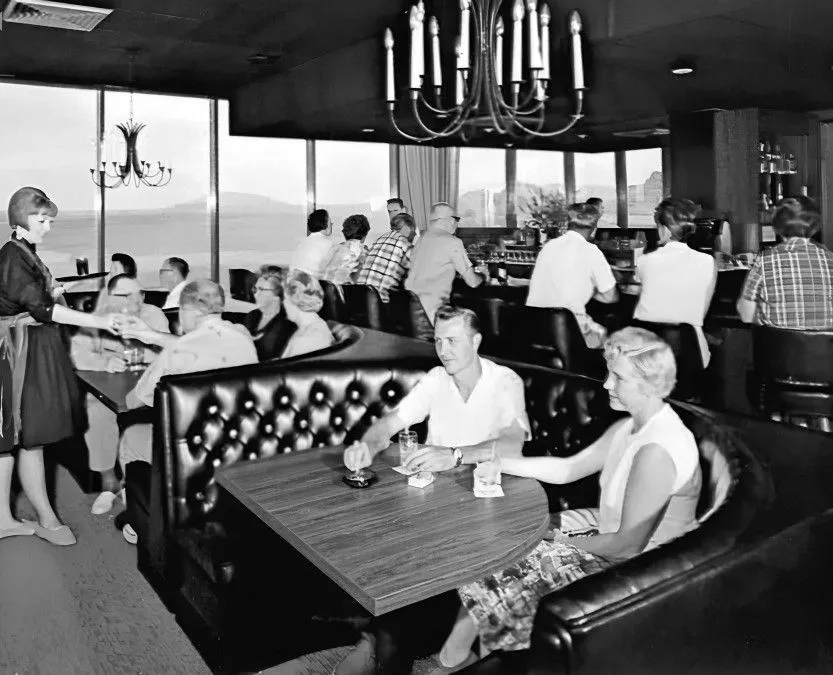 @11 Hotel Features You Won’t Find Anymore/American Rewind/YouTube.com
@11 Hotel Features You Won’t Find Anymore/American Rewind/YouTube.com
These rooms were like private clubs where guests could unwind, socialize, and discuss the latest news. Sounds classy—if only smoking weren’t so unhealthy!
The Telephone System Run by Operators
Today, making a call is as simple as tapping a button on your smartphone. But back in the day, making a call was a little theatrical! Many hotels had switchboard operators who manually connected guests’ calls.
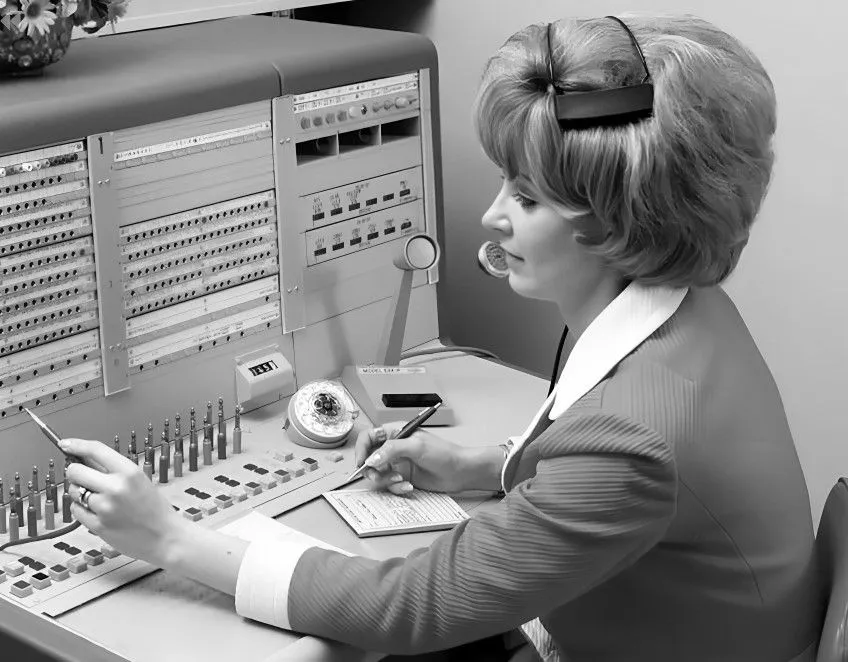 @11 Hotel Features You Won’t Find Anymore/American Rewind/YouTube.com
@11 Hotel Features You Won’t Find Anymore/American Rewind/YouTube.com
There were no automatic systems—these operators plugged in cables to connect callers and could even ring your room if someone was trying to reach you. Some regular guests even had their “favorite operators,” enjoying small talk with them before being connected.
Radio Alarm Clocks – The Pre-iPhone Wake-Up Call
Every hotel room used to have a big, clunky alarm clock-radio by the bed. It was a must-have if you didn’t want to oversleep and miss breakfast—or your flight home!
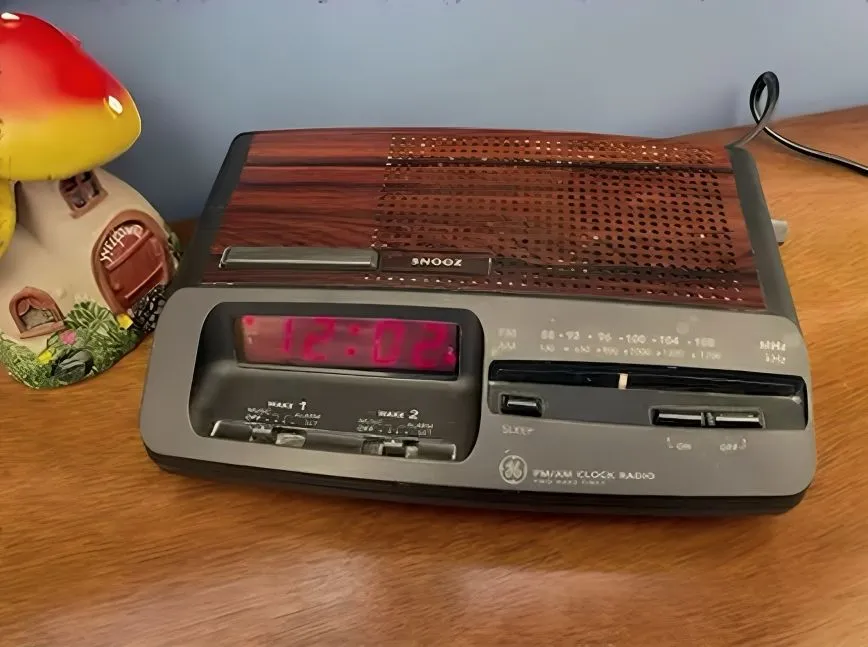 @Hotel Features You Won't Find Anymore/Memory Surge/YouTube.com
@Hotel Features You Won't Find Anymore/Memory Surge/YouTube.com
These devices tuned in to local radio stations, and some could even play cassette tapes. But figuring out how to set the alarm? That was a challenge! Often, it was easier to ask the front desk for a wake-up call than to decode the mysterious buttons on the clock.
Toilets with Pull Chains
Flushing a toilet today is as simple as pressing a button. But in the past, hotel bathrooms often had pull-chain toilets with a long chain hanging from the tank above. These were common well into the 1980s, and many travelers still remember them fondly.
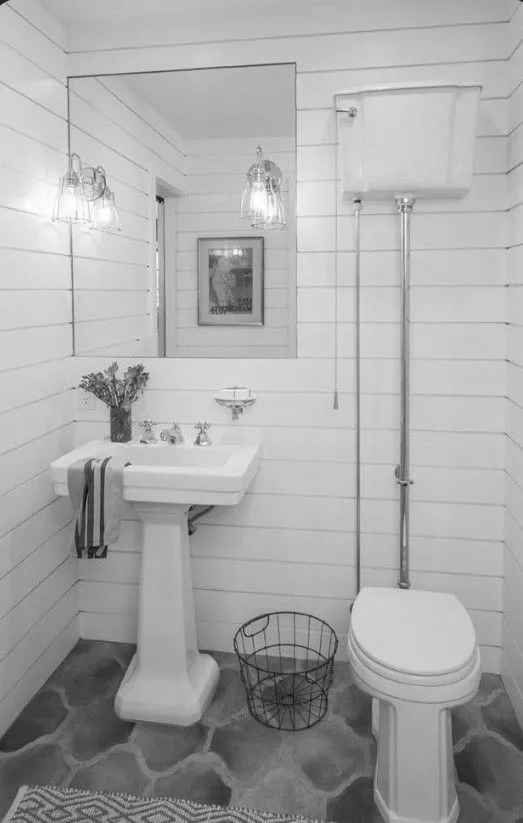 @Hotel Features You Won't Find Anymore/Memory Surge/YouTube.com
@Hotel Features You Won't Find Anymore/Memory Surge/YouTube.com
That is, unless the chain got stuck—then you had to get creative to get things working again! While these toilets are now rare, some historic hotels in Europe still keep them for nostalgia’s sake.
Housekeepers in Traditional Uniforms
Nowadays, hotel housekeeping staff wear comfortable and practical uniforms. But back in the day, there was a strict dress code: neatly pressed dresses, aprons, and white caps—just like in classic movies!
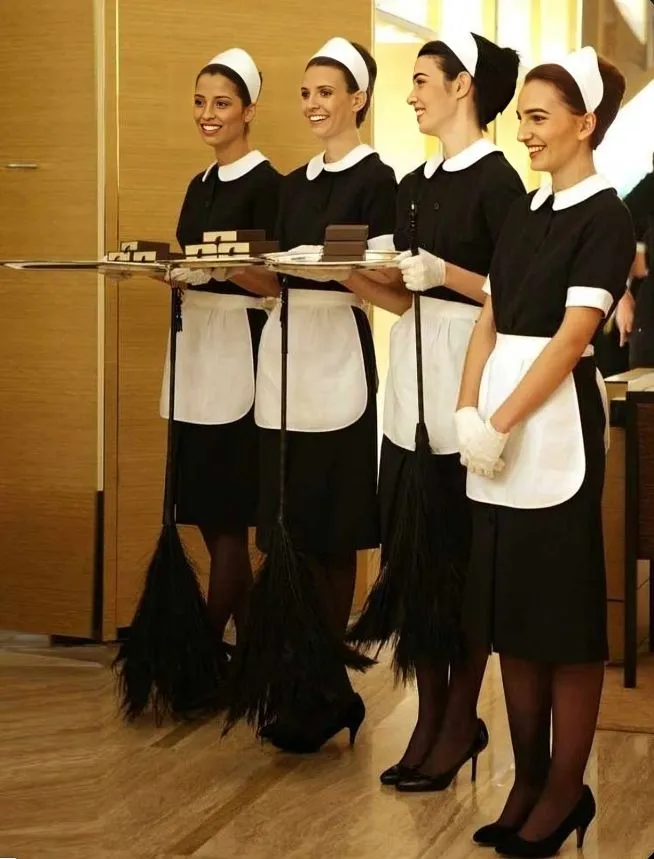 @Hotel Features You Won't Find Anymore/Memory Surge/YouTube.com
@Hotel Features You Won't Find Anymore/Memory Surge/YouTube.com
This uniform was meant to reflect a high standard of service but in reality, it wasn’t very practical for physical work. Over time, hotels swapped these old-fashioned outfits for more comfortable attire.
Fax Machines in Hotel Rooms
Fax machines may seem like relics of the past but in the 1990s and early 2000s, they were an essential tool for business travelers. Some high-end hotels even provided personal fax machines in guest rooms so visitors could send and receive documents without leaving their suites.
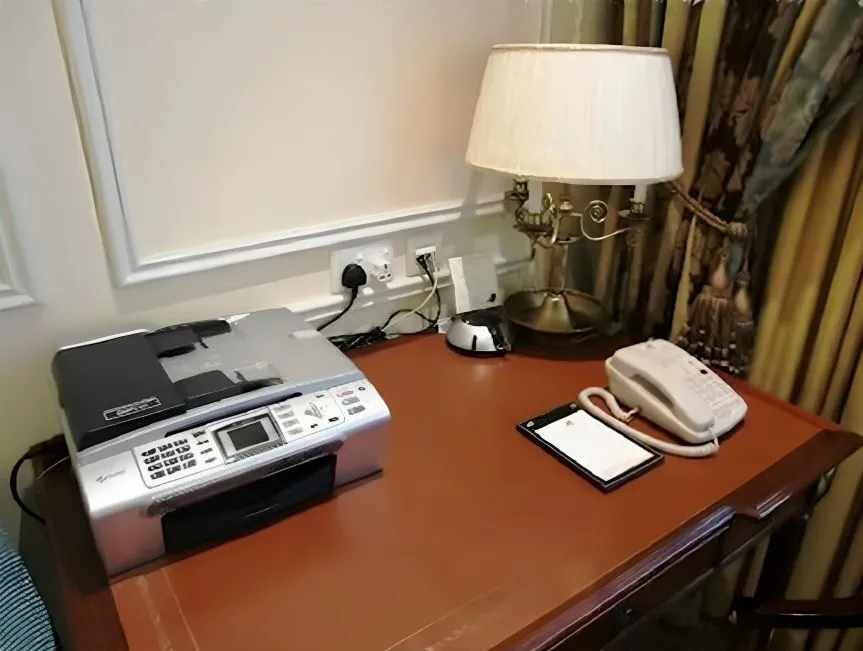 @Hotel Features You Won't Find Anymore/Memory Surge/YouTube.com
@Hotel Features You Won't Find Anymore/Memory Surge/YouTube.com
Today, with emails and instant messaging, the idea of needing a fax machine feels almost comical. But back then, it was a sign of a luxury hotel that truly catered to professionals.
Pay Phones in Hotel Lobbies and Rooms
Before mobile phones, making a call while traveling wasn’t so easy. Many hotels had coin-operated payphones in lobbies, hallways, or even guest rooms. To use them, you had to drop in a coin, wait for the dial tone, and then dial your number.
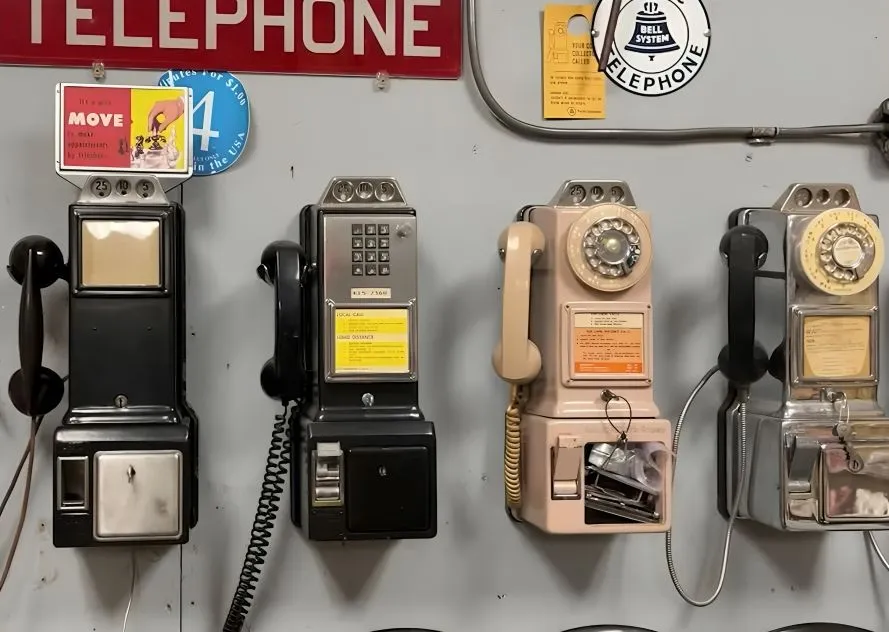 @Hotel Features You Won't Find Anymore/Memory Surge/YouTube.com
@Hotel Features You Won't Find Anymore/Memory Surge/YouTube.com
There was usually a sign nearby explaining the cost for local and international calls. The tricky part? If you ran out of money mid-call, the conversation would suddenly cut off—forcing you to scramble for another coin to keep talking!
Room Service That Cleaned and Polished Shoes
Today, room service is mostly about delivering food. But in the past, hotels offered an exclusive shoe-cleaning and polishing service. Guests could leave their shoes outside their room at night, and by morning, they’d be returned perfectly polished. This service was especially popular with business travelers who needed to look sharp.
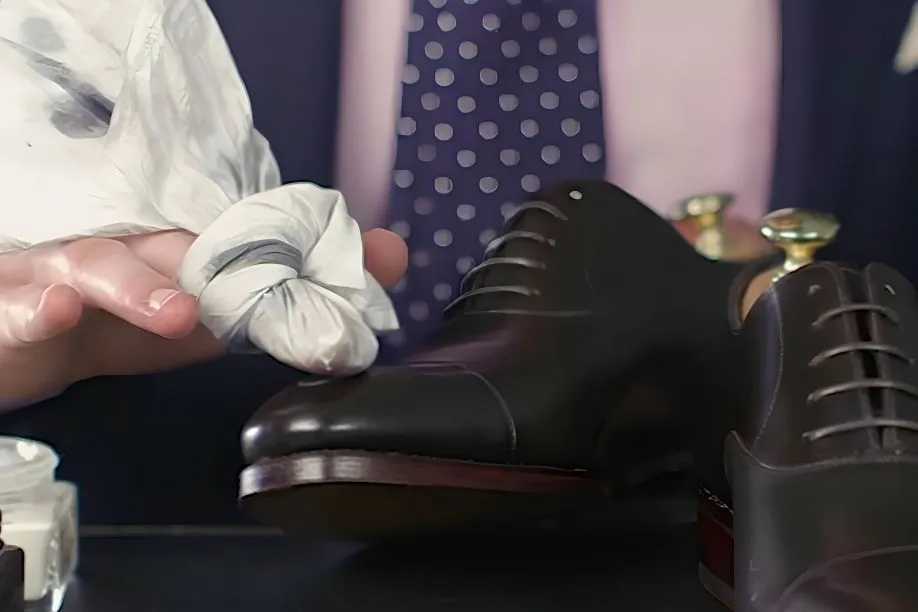 @Hotel Features You Won't Find Anymore/Memory Surge/YouTube.com
@Hotel Features You Won't Find Anymore/Memory Surge/YouTube.com
Some hotels had staff who polished shoes by hand, while others used special machines. While this tradition has mostly disappeared, some luxury hotels still have automatic shoe-shining machines tucked away in the hallways.
Elevator Operators – A Profession of the Past
Today, elevators run automatically but there was a time when they were operated by real people. These uniformed attendants didn’t just press buttons—they literally "drove" the elevator, stopping it at the right floor using a lever.
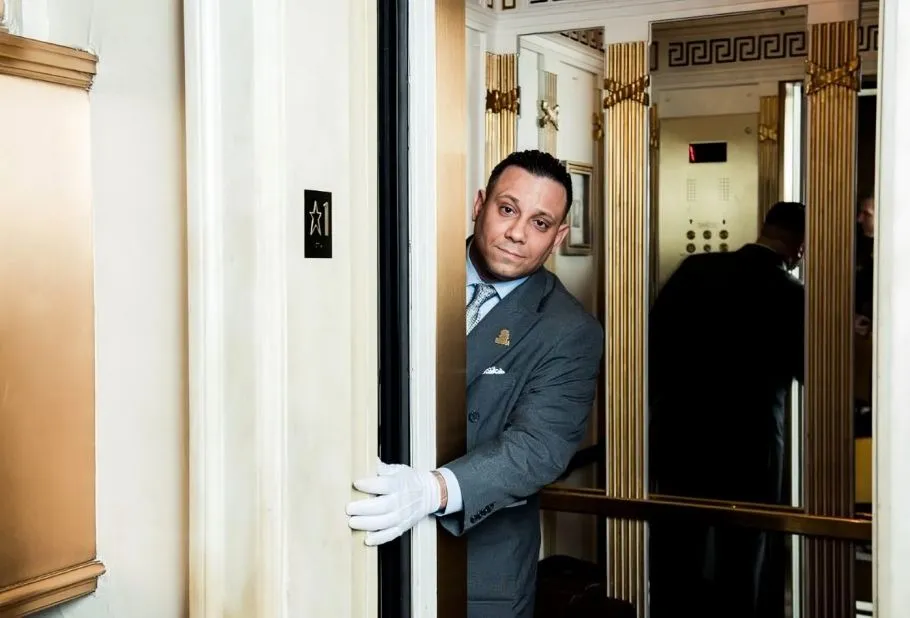 @nytimes.com
@nytimes.com
Elevator operators were also like informal concierges. They could direct guests to the restaurant, recommend a good room, or simply make small talk. In luxury hotels, operators knew regular guests by name and even remembered their preferences.
Unlimited Lobster Tails
Of course, a lot has changed on cruise ships, and not always for the better… Today, cruise ships are still a paradise for food lovers but if you had taken a sea voyage 30 years ago, you would have had the chance to enjoy the most elite seafood! Cruise lines used to spoil guests with unlimited lobsters. Want five tails? No problem. Ten? Your table is already piled high but the waiter will bring more!
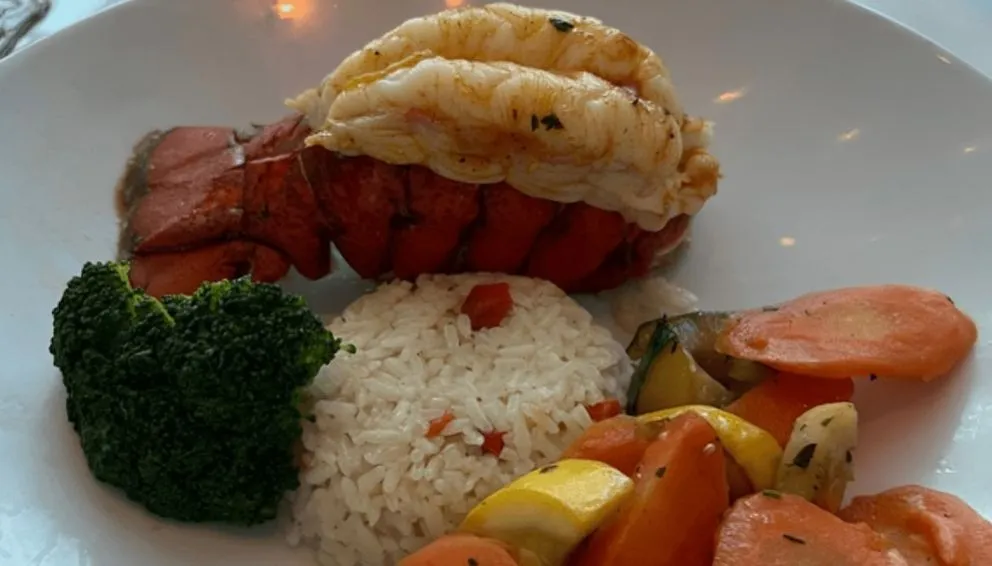 @cruisehabit.com
@cruisehabit.com
Unfortunately, such generosity is a thing of the past. Lobsters are too expensive, and now they are either limited to one or two portions per person or included only on premium restaurant menus for an additional fee. But back then? You could order a whole bucket if you wanted!
Chocolates on the Pillow
Returning to your cabin after dinner and finding neatly arranged bedding with a small piece of chocolate on top—such a small detail, yet so heartwarming! Many cruise lines used to make this a signature part of their service—the chocolate was either classic or embossed with the company’s logo.
 @cruisehabit.com
@cruisehabit.com
It was a lovely touch for passengers, wasn’t it? But times have changed. Today, it is believed that guests eat less chocolate before bed, and cruise lines are cutting costs on such little details. A shame, really—after all, you could always eat the chocolate in the morning!
Shared Dining Tables and Meeting New Friends
Nowadays, everything on cruises is personalized: if you want to dine alone, you can; if you prefer a romantic table for two, no problem. But back then… you sat at a massive communal table with strangers and had to make new friends!
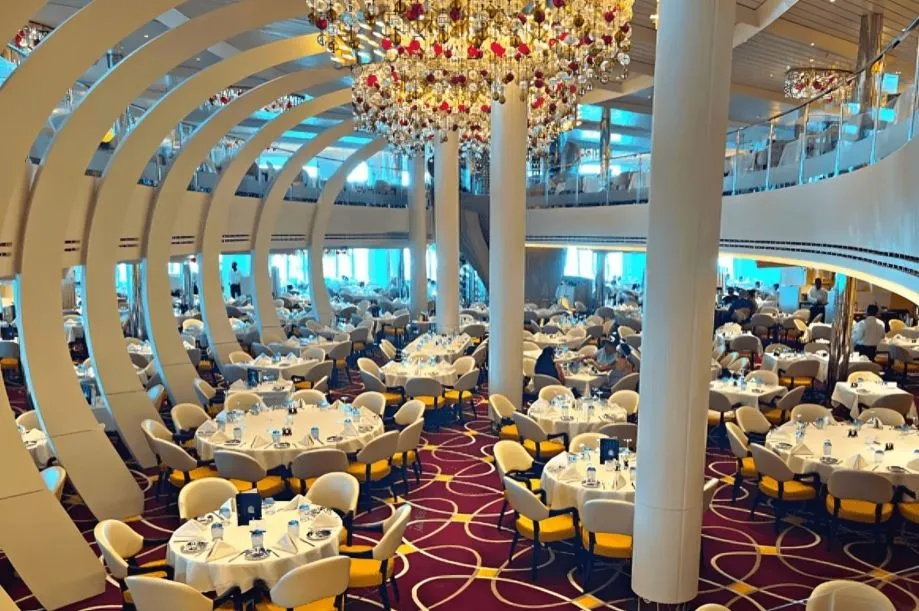 @cruisehabit.com
@cruisehabit.com
During the “golden age of cruising,” it was standard practice to seat people at large tables so they could chat, get to know each other, and share stories. Some found lifelong friends, while others met their soulmates.
All-Inclusive Dining Options
Nowadays, even cruises have paid restaurants and extra-charge dining options. But in the past? You paid once for your ticket and could eat as much as you wanted, wherever and whenever you wanted! No extra charges for steaks, sushi, or pasta in an Italian restaurant.
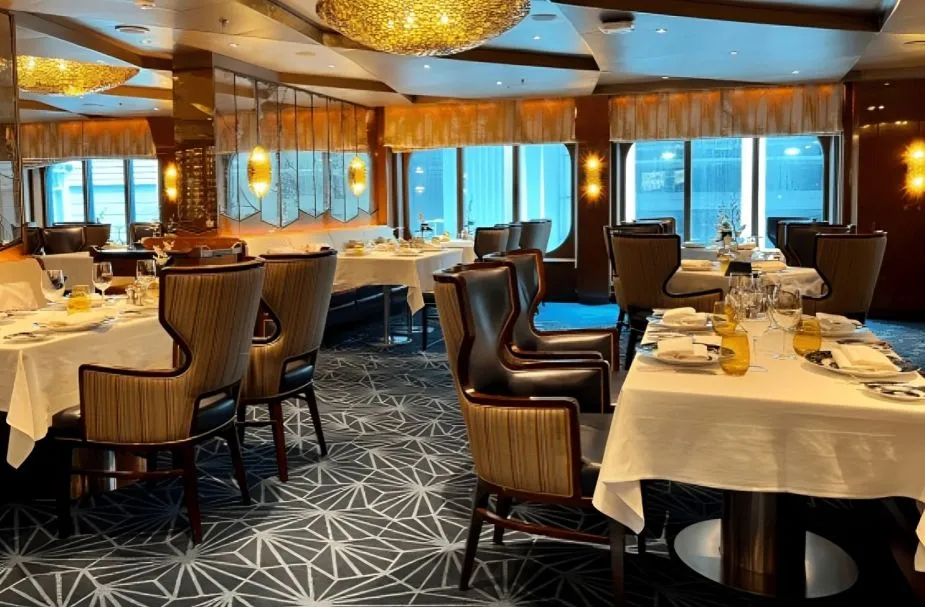 @cruisehabit.com
@cruisehabit.com
Everything was included, and passengers could enjoy gourmet delights without worrying about the bill. Today, things are more complicated. Of course, there are still restaurants offering free meals but many special dishes now come with an extra fee.
Ice Carving Demonstrations
Cruises used to feature entire shows dedicated to ice carving. In the middle of the deck, a master carver (often the head chef) would appear with a chainsaw, and within minutes, a shapeless ice block would transform into a giant eagle or a sailing ship.
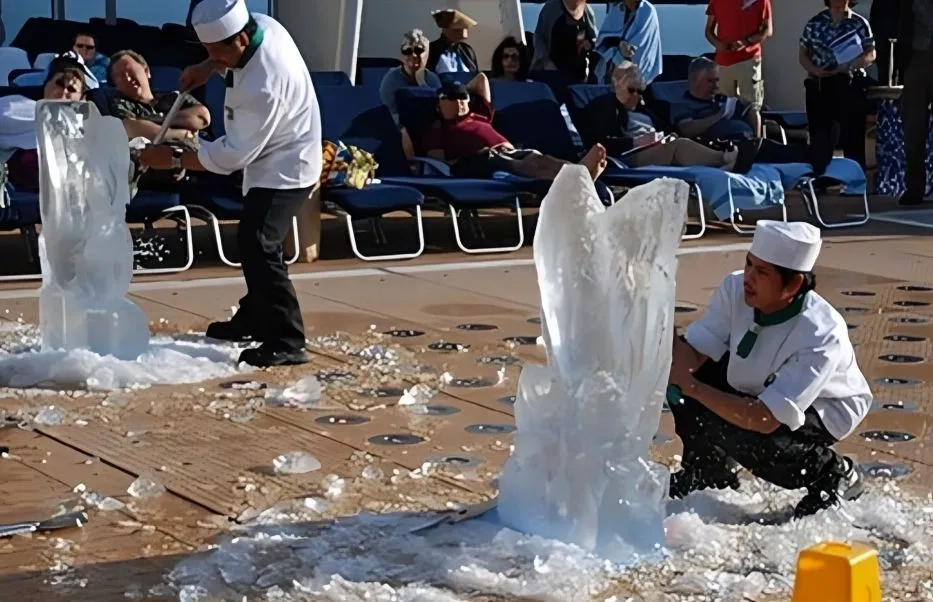 @cruisehabit.com
@cruisehabit.com
It was mesmerizing! Passengers watched in awe as ice shavings flew in all directions, and a true work of art emerged before their eyes. Today, such shows are rare. Yes, you can still find ice sculptures on ships but they are usually made behind the scenes and simply displayed in the buffet area. The live performances, unfortunately, are a thing of the past.
Midnight Buffets
Have you ever had dinner number two? On older cruises, this was the norm! Every night, a grand midnight buffet was set up, drawing in all those who weren’t quite full yet (and there were many!). Giant pies, enormous appetizers, massive meat dishes—everything was supersized! It was a true ritual: guests in evening attire would step out onto the deck once more to enjoy another lavish meal before bed.
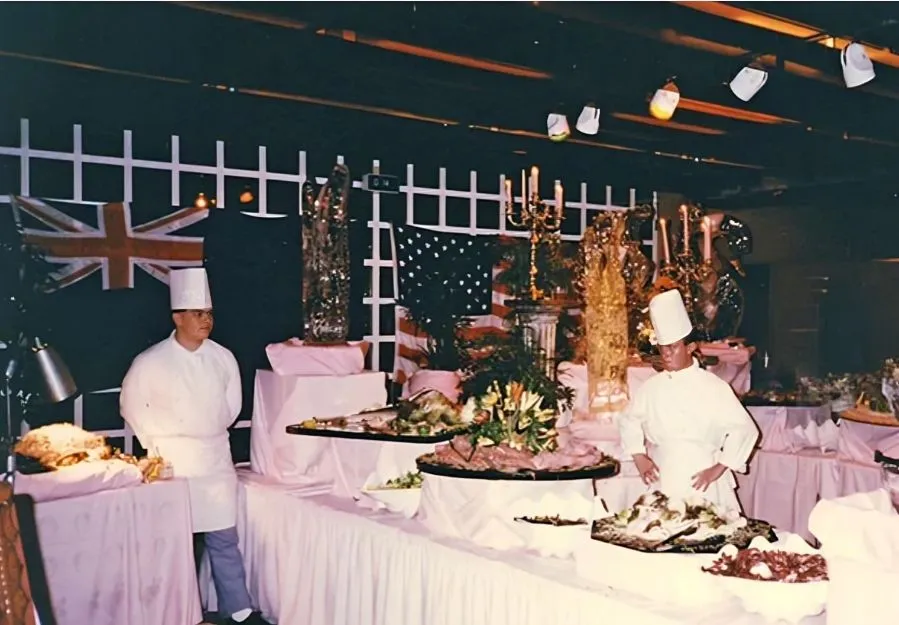 @cruisehabit.com
@cruisehabit.com
Nowadays, midnight buffets have almost disappeared—people have become more mindful of their eating habits, and cruise kitchens find it harder to prepare food that may go to waste.
A Maid Unpacking Your Suitcase
Imagine stepping into your cruise cabin and finding… a personal maid waiting to unpack your suitcase. Once upon a time, this was a standard service on luxury cruises! In the early 20th century and even in the 1950s–60s, there were special attendants on board who helped guests organize their belongings—hanging up suits, folding dresses, and arranging everything neatly in the wardrobe.
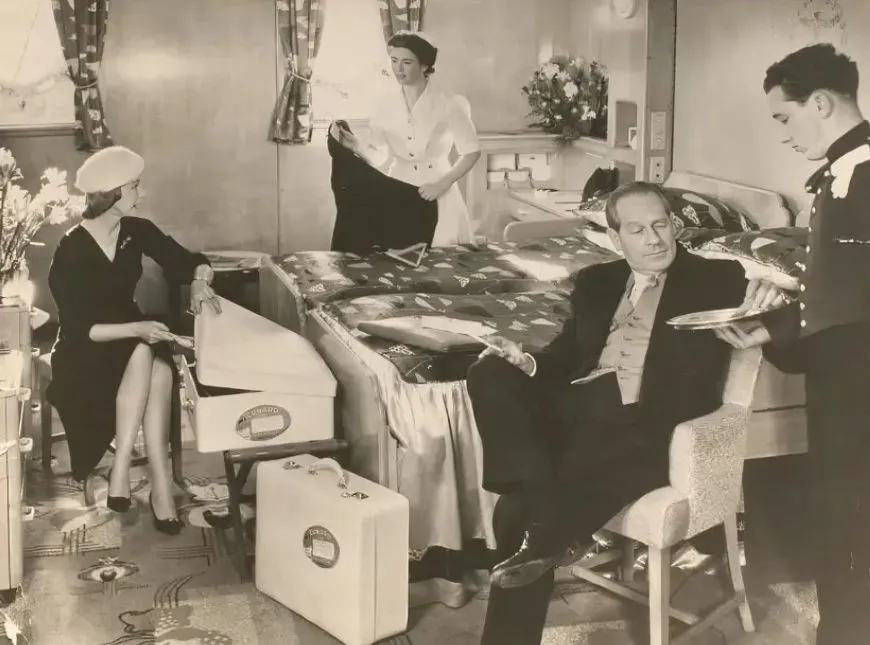 @edition.cnn.com
@edition.cnn.com
This was especially useful for wealthy passengers who traveled not with just one suitcase but with an entire wardrobe. Nowadays, no one is going to unpack your things (unless you’re on an ultra-luxury cruise) but just the thought of passengers never having to worry about their luggage is enough to make us a little jealous.
Interiors Fit for Royalty
Today’s cruise ships are undeniably luxurious but their design leans toward modern aesthetics—lots of glass, shiny metal, and neon lights. In the past, however, ships resembled floating palaces with museum-worthy elegance!
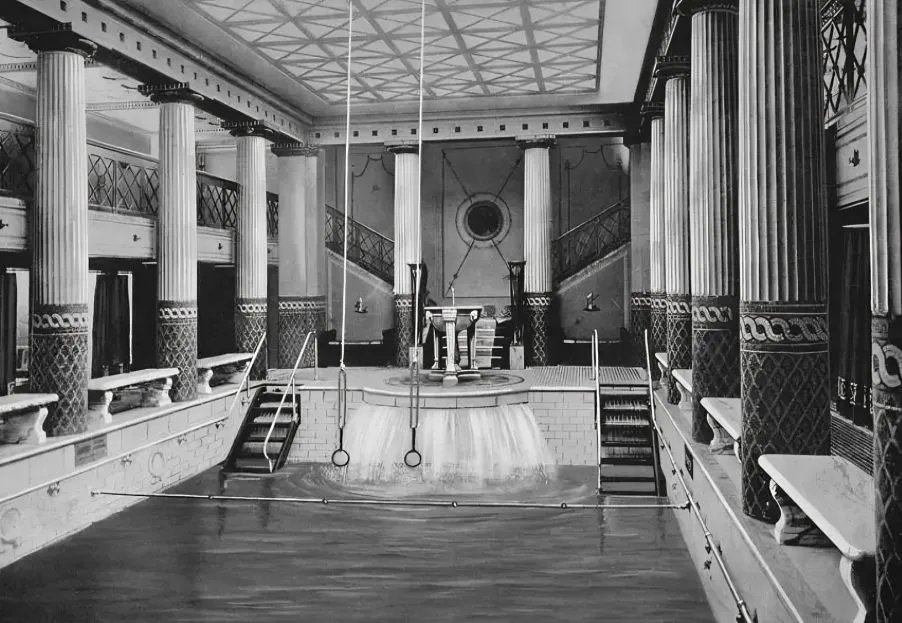 @edition.cnn.com
@edition.cnn.com
For example, the legendary RMS Titanic and Queen Mary featured massive wooden panels, marble, gilded details, crystal chandeliers, and plush carpets. But the most astonishing feature? Some ships even had fountains! On cruise liners of the 1920s and 1930s, you could find small marble pools and decorative fountains. Wow!